graphic contextжҳҜеңЁGCҫcЦMёӯзҡ„пјҢGCеҜ№иұЎжҳҜйҷ„зқҖдәҺзҺ°еӯҳзҡ„ControlsгҖ?br />
иҰҒеҲӣе»ЮZёҖдёӘgraphically orientedзҡ„еә”з”ЁзЁӢеәҸпјҢйҰ–е…ҲиҰҒеҲӣе»әgraphic contextеQҢеЖҲһ®Ҷе…¶дёҺдёҖдёӘcomponentзӣёе…іиҒ”пјҢҳqҷдёӨжӯҘйғҪеҸҜйҖҡиҝҮGCзҡ„constructorжқҘе®һзҺ°гҖӮе…ұжң?дёӘжһ„йҖ еҮҪж•ҺНјҢи§ҒдёӢеQ?br />1. GC(Drawable)--Creates a GC and configures it for the Drawable object
2. GC(Drawable, int)--Creates and configures a GC and sets the text-display styleеQҢ第дәҢдёӘеҸӮж•°еҸҜд»ҘжҳҜRIGHT_TO_LEFTжҲ–LEFT_TO_RIGHTеQҲй»ҳи®ӨеҖы|јү;
ҪW¬дёҖдёӘеҸӮж•°йңҖиҰҒе®һзҺ°DrawableжҺҘеҸЈзҡ„еҜ№иұЎпјҢ жӯӨжҺҘеҸЈеҢ…еҗ«дәҶдёҺgraphic context.еҶ…йғЁзӣёиҒ”ҫpИқҡ„ж–ТҺі•гҖӮSWTжҸҗдҫӣдәҶдёүдёӘе®һзҺ°DrawableжҺҘеҸЈзҡ„зұ»еQҡImage, Device,В е’?Control.
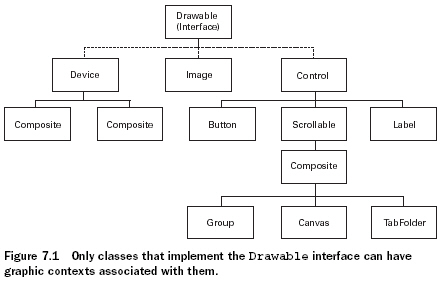
Controlеӯҗзұ»иҷҪ然йғҪиғҪеҢ…еҗ«еӣ‘ЦЕһеQҢдҪҶеҸӘжңүдёҖдёӘзұ»жҳҜзү№еҲ«йҖӮеҗҲGCеҜ№иұЎзҡ„пјҡCanvasгҖӮе®ғдёҚд»…жҸҗдҫӣдәҶдёҖдёӘCompositeзҡ„containment propertyеQҢиҝҳеҸҜд»Ҙз”ЁдёҖҫpХdҲ—зҡ„йЈҺж јжқҘе®ҡд№үеӣ‘ЦЕһеңЁжӯӨеҢәеҹҹеҶ…еҰӮдҪ•жҳҫҪC?br />
ҪCЮZҫӢеQ?/u>
package com.swtjface.Ch7;
import org.eclipse.swt.SWT;
import org.eclipse.swt.graphics.*;
import org.eclipse.swt.widgets.*;
public class DrawExample
{
public static void main (String [] args)
{
Display display = new Display();
Shell shell = new Shell(display);
shell.setText("Drawing Example");
Canvas canvas = new Canvas(shell, SWT.NONE);
canvas.setSize(150, 150);
canvas.setLocation(20, 20);//еңЁshellдёӯеҲӣе»әcanvas
shell.open ();
shell.setSize(200,220);
GC gc = new GC(canvas);//еңЁcanvasдёӯеҲӣе»?/font>graphic context
gc.drawRectangle(10, 10, 40, 45);
gc.drawOval(65, 10, 30, 35);
gc.drawLine(130, 10, 90, 80);
gc.drawPolygon(new int[] {20, 70, 45, 90, 70, 70});
gc.drawPolyline(new int[] {10,120,70,100,100,130,130,75});
gc.dispose();//йҮҠж”ҫColorеҜ№иұЎ
while (!shell.isDisposed())
{
В if (!display.readAndDispatch())
В display.sleep();
В }
В display.dispose();
В }
В }
жңүдёӨзӮҡwңҖиҰҒжіЁж„Ҹпјҡ1.еңЁи°ғз”Ёshell.open()д№ӢеүҚжһ„еҫҸCanvasеҜ№иұЎеQҢ然еҗҺеңЁи°ғз”Ёshell.open()д№ӢеҗҺеҲӣеҫҸе’ҢдӢЙз”ЁGCеҜ№иұЎ
В В В В В В В В В В В В В В В В В В В В 2.еңЁдӢЙз”Ёе®Ңд№ӢеҗҺдёҖе®ҡиҰҒз«ӢеҚійҮҠж”ҫGC object
еҰӮдёҠдҫӢжүҖҪCәGCжҸҗдҫӣдәҶдёҖҫpХdҲ—еңЁDrawableеҜ№иұЎдёҠз”»еӣ‘ЦЕһзҡ„ж–№жі•пјҢеҰӮдёӢеQ?br />

дҪҶжҳҜдёҠдҫӢдёӯжңүдёӘй—®йўҳпјҡеҪ“shellиў«еҸҳзҒ°иҝҮжҲ–иҖ…жңҖһ®ҸеҢ–ҳqҮд№ӢеҗҺпјҢеӣ‘ЦЕһһ®Чғјҡиў«ж“ҰеҺ…RҖӮжүҖд»ҘжҲ‘们йңҖиҰҒи§ЈеҶізҡ„дәӢпјҢж— и®әwindowжҖҺд№ҲеҸҳеҢ–еQҢеӣҫеҪўйғҪдҝқжҢҒеҸҜи§ҒгҖӮеӣ жӯӨSWTеңЁдёҖдё?/span>DrawableеҜ№иұЎиў«еҲ·ж–°еҗҺи®©дҪ иҮӘиЎҢжҺ§еҲ¶гҖӮиҝҷдёӘжӣҙж–°зҡ„ҳqҮзЁӢһ®Юpў«ҝUоCШ“paintingгҖ?/span>
Painting and PaintEvents
еҪ“дёҖдёӘGCж–ТҺі•еңЁдёҖдёӘDrawabelеҜ№иұЎдёҠз”»еҮЮZёҖдёӘеӣҫжЎҲпјҢе®ғд»…жү§иЎҢҳqҷдёӘpaintingҳqҮзЁӢдёҖӢЖЎгҖӮеҰӮжһңз”ЁжҲдh”№еҸҳеҜ№иұЎе°әеҜёжҲ–жҳҜз”ЁеҸҰдёҖдёӘзӘ—еҸЈеҺ»иҰҶзӣ–е®ғпјҢеҲҷеӣҫеҪўдјҡиў«ж¶ҲйҷӨгҖӮеӣ жӯӨпјҢеә”з”ЁҪEӢеәҸиғҪеҗҰеңЁеӨ–з•ҢдәӢ件еӘ„е“ҚдёӢҫlҙжҢҒе…¶еӨ–и§ӮиҝҷдёҖзӮ№зӣёеҪ“йҮҚиҰҒгҖ?br />
ҳqҷдәӣеӨ–йғЁдәӢдҡgиў«з§°дёәPaintEventsеQҢжҺҘ收е®ғ们зҡ„ҪEӢеәҸжҺҘеҸЈжҳҜPaintListenerгҖӮдёҖдёӘControlеңЁд“QдҪ•ж—¶еҖҷеҪ“е…¶еӨ–и§Ӯиў«еә”з”ЁҪEӢеәҸжҲ–жҳҜеӨ–з•ҢӢzХdҠЁж”№еҸҳйғҪдјҡи§ҰеҸ‘дёҖдёӘPaintEventгҖӮиҝҷдәӣзұ»еҜ№дәҺдәӢдҡgе’Ңзӣ‘еҗ¬еҷЁзҡ„дӢЙз”Ёж–№ејҸйғҪе’ҢжҲ‘们еңЁҪW¬еӣӣз« еҶ…жҸҗеҲ°зҡ„зұ»дј№{ҖӮз”ұдәҺPaintListenerеҸӘжңүдёҖдёӘдәӢ件еӨ„зҗҶж–№жі•пјҢжүҖд»ҘдёҚйңҖиҰҒдӢЙз”Ёadapterҫc?br />
Canvas canvas = new Canvas(shell, SWT.NONE);
canvas.setSize(150, 150);
canvas.setLocation(20, 20);
canvas.addPaintListener(new PaintListener()
{
public void paintControl(PaintEvent pe)
{
GC gc = pe.gc;//жҜҸдёҖдёӘPaintEventеҜ№иұЎйғҪеҢ…еҗ«жңүе…¶иҮӘе·Юqҡ„GC
gc.drawPolyline(new int[] {10,120,70,100,100,130,130,75});
}
});
shell.open();
жҜҸдёҖдёӘPaintEventеҜ№иұЎйғҪеҢ…еҗ«жңүе…¶иҮӘе·Юqҡ„GCеQҢдё»иҰҒжңү2дёӘеҺҹеӣ пјҡ1.еӣ дШ“ҳqҷдёӘGC instanceжҳҜз”ұдәӢдҡgдә§з”ҹзҡ„пјҢжүҖд»ҘPaintEventдјҡиҙҹиҙЈйҮҠж”ҫд»–гҖ?.еә”з”ЁҪEӢеәҸеҸҜд»ҘеңЁshell openд№ӢеүҚеҲӣеҫҸGC,ҳqҷж ·еҸҜд»ҘдҪҝеӣҫеҪўеңЁдёҖдёӘзӢ¬з«Ӣзҡ„ҫcЦMёӯиў«еҲӣе»әгҖ?/font>
SWTең?/span>PaintListenerжҺҘеҸЈеҶ…дјҳеҢ?/span>paintingҳqҮзЁӢ,SWTзҡ„ејҖеҸ‘иҖ…ејәзғҲеҫҸи®?/span>Controlзҡ?/span>paintingд»…еҜ№PaintEventдҪңеҮәеҸҚеә”гҖӮеҰӮжһңдёҖдёӘеә”з”ЁзЁӢеәҸеӣ дёәе…¶д»–еҺҹеӣ еҝ…ҷеАLӣҙж–°е…¶еӣ‘ЦЕһеQҢеҲҷ他们жҺЁиҚҗдҪҝз”Ёcontrolзҡ?/span>redraw()ж–ТҺі•еQҢиҝҷдјҡеңЁйҳҹеҲ—дёӯеҠ е…ҘдёҖдё?/span>paintиҜдhұӮгҖӮд№ӢеҗҺпјҢдҪ еҸҜд»Ҙи°ғз”?/span>update()ж–ТҺі•жқҘеӨ„зҗҶжүҖжңүзҡ„ҫl‘е®ҡдәҺиҜҘеҜ№иұЎзҡ?/span>paintиҜдhұӮгҖ?br />
йңҖиҰҒзүўи®°зҡ„жҳҜпјҢиҷҪ然еҜ№дәҺControlеҜ№иұЎжҺЁиҚҗеңЁдёҖдёӘPaintListenerеҶ…paintingеQҢдҪҶжҳҜз”ұдәҺDeviceе’ҢImageеҜ№иұЎтq¶дёҚиғҪеңЁиҜҘжҺҘеҸЈеҶ…дҪҝз”ЁгҖӮеҰӮжһңдҪ йңҖиҰҒеңЁдёҖдёӘimageжҲ–deviceеҶ…з”ҹжҲҗеӣҫеҪўпјҢдҪ еҝ…ҷеХdҚ•зӢ¬ең°з”ҹжҲҗдёҖдёӘGCеҜ№иұЎтq¶еңЁдҪҝз”Ёҫl“жқҹеҗҺе°Ҷе…үҷ”ҖжҜҒгҖ?/span>
computeSize()
protected Point computeSize(Composite composite,
int wHint, int hHint,
boolean flushCache)
{
Point maxDimensions =
calculateMaxDimensions(composite.getChildren());
int stepsPerHemisphere =
stepsPerHemisphere(composite.getChildren().length);
int maxWidth = maxDimensions.x;
int maxHeight = maxDimensions.y;
int dimensionMultiplier = (stepsPerHemisphere + 1);
int controlWidth = maxWidth * dimensionMultiplier;
int controlHeight = maxHeight * dimensionMultiplier;
int diameter = Math.max(controlWidth, controlHeight);
Point preferredSize = new Point(diameter,
diameter);
... // code to handle case when our calculations
// are too large
return preferredSize;
}
еҸӮж•°еQ?br />1.composite--The object weвҖҷre going to populate. At the time this method is called, it has children, but neither the composite nor the children have been sized or positioned on the screen.
2.wHint and hHint--layoutжүҖйңҖзҡ„жңҖеӨ§й•ҝе®ҪгҖӮиӢҘеёҰжңүеҸӮж•°SWT.DEFAULT,иЎЁзӨәжӯӨlayoutеҸҜд»ҘйҡҸж„ҸдҪҝз”Ёuse whatever sizes it decides it needs.
3.flushCache--дҪңдШ“flagеQҢto tell the layout whether itвҖҷs safe to use any cached values that it may be maintaining.
computeSize()зҡ„зӣ®зҡ„дё»иҰҒеңЁдәҺи®ЎҪҺ—жҲ‘们иҰҒlayoutзҡ„compositeжңүеӨҡеӨ?br />layout()
вҖҰвҖ?br />
FormLayoutеҚҒеҲҶҪҺҖеҚ•пјҢдҪ еҸӘиҰҒпјҡ1.и®‘Ц®ҡҷеөиҫ№и·қпјҲй«ҳпјҢе®ҪпјүеұһжҖ§гҖ?2.и®‘Ц®ҡspacingеұһжҖ§пјҢеҚПxүҖжңүcontrolй—ҙзҡ„и·қзҰ»(in pixels)
еҗҢж ·еҸҜд»ҘдҪҝз”ЁFormDataжқҘй…Қҫ|®еҚ•дёӘзҡ„controlгҖ?br />
FormData
еҰӮжһңдёҖдёӘcontrolжІЎжңүдёҖдёӘFormDataе®һдҫӢжқҘжҸҸҳq°е®ғзҡ„иҜқеQҢе°ұдјҡй»ҳи®Өж”ҫеңЁcompositeзҡ„еҸідёҠи§’
widthе’ҢheightеұһжҖ§жҢҮе®ҡдәҶcontrolзҡ„е°әеҜёпјҢin pixels.
top, bottom, right, е’ҢleftеұһжҖ§пјҢжҜҸдёҖдёӘйғҪжңүдёҖдёӘFormAttachmentе®һдҫӢеQҢиҝҷдәӣattachmentsжҸҸиҝ°дәҶcontrolдёҺе…¶д»–controlд№Ӣй—ҙзҡ„е…іҫp…RҖ?br />
FormAttachment
жң?дёӘдӢЙз”ЁйҖ”еҫ„еQ?br />1.йҖҡиҝҮдҪҝз”Ёpercentage of the parent composite.
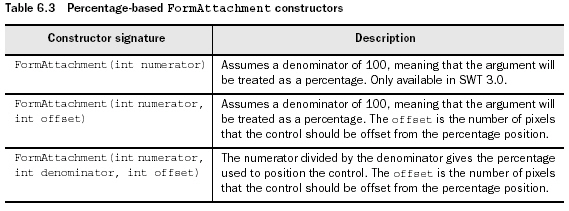
2.йҖҡиҝҮи®‘Ц®ҡдёҖдёӘcontrolе’ҢеҸҰдёҖдёӘcontrolд№Ӣй—ҙзҡ„зӣёеҜ№дҪҚҫ|®В?br />гҖҠеӣҫгҖ?br />
package com.swtjface.Ch6;
import org.eclipse.swt.*;
import org.eclipse.swt.widgets.*;
import org.eclipse.swt.layout.*;
public class Ch6FormLayoutComposite extends Composite {
public Ch6FormLayoutComposite(Composite parent) {
super(parent, SWT.NONE);
FormLayout layout = new FormLayout();
setLayout(layout);
Text t = new Text(this, SWT.MULTI);
FormData data = new FormData();
data.top = new FormAttachment(0, 0);
data.left = new FormAttachment(0, 0);
data.right = new FormAttachment(100);
data.bottom = new FormAttachment(75);//јӢ®е®ҡtextзҡ„дҪҚҫ|®пјҢеӣ дШ“е·ҰдёҠи§’жҳҜеқҗж ҮеҺҹзӮ№еQҢжүҖд»Ҙrightзҡ„зҷҫеҲҶж•°дё?00гҖ?br />t.setLayoutData(data);
Button ok = new Button(this, SWT.NONE);
ok.setText("Ok");
Button cancel = new Button(this, SWT.NONE);
cancel.setText("Cancel");
data = new FormData();
data.top = new FormAttachment(t);
data.right = new FormAttachment(cancel);//okжҢүй’®еңЁtextдёӢйқўеQҢcancelе·Ұиҫ№
ok.setLayoutData(data);
data = new FormData();
data.top = new FormAttachment(t);
data.right = new FormAttachment(100);//cancelжҢүй’®еңЁtextдёӢйқўеQҢеңЁжңҖеҸҢҷҫ№
cancel.setLayoutData(data);
}
}
package com.swtjface.Ch6;
import org.eclipse.swt.*;
import org.eclipse.swt.widgets.*;
import org.eclipse.swt.layout.*;
public class Ch6GridLayoutComposite extends Composite {
public Ch6GridLayoutComposite(Composite parent) {
super(parent, SWT.NONE);
GridLayout layout = new GridLayout(4,false);//жҜҸдёҖиЎҢжңү4дёӘcontrolеQҢеҗҺдёҖдёӘеҸӮж•°жҳҜa
boolean to indicate whether the columns should take up an even amount of
space. By passing false, you tell the layout to only use the minimum amount of
space needed for each column.
setLayout(layout);
for (int i = 0; i < 16; ++i) {
Button button = new Button(this, SWT.NONE);
button.setText("Cell " + i);
}
}
}
Using GridData styles
еҚҒеҲҶҫcЦMјјдәҺRowDataеҜ№иұЎгҖӮеҸҜйҖҡиҝҮе…¶жһ„йҖ еҮҪж•°жқҘи®‘Ц®ҡSTYLEеQҢиҝҷдәӣSTYLEеҸҜеҲҶдё?ҫc»пјҡFILL, HORIZONTAL_ALIGN, and VERTICAL_ALIGN.
1.FILL:жӯӨcellжҳҜеҗҰfillжүҖжңүзҡ„availabeзҡ„з©әй—ҙгҖӮеҸҜз”Ёзҡ„еҖЖDҝҳеҢ…жӢ¬FILL_HORIZONTALеQҲж°ҙтqПxү©еј пјү,FILL_VERTICALеQҲеһӮзӣҙжү©еј пјү,FILL_BOTHгҖ?br />2.ALIGNеQҢз”ЁжқҘжҢҮе®ҡcontrolеңЁcellдёӯзҡ„д»Җд№ҲдҪҚҫ|®гҖӮеҖјеҢ…жӢ¬BEGINNING, END, CENTERе’ҢFILLгҖ?br />е…·дҪ“еҸӮи§ҒдёӢиЎЁ
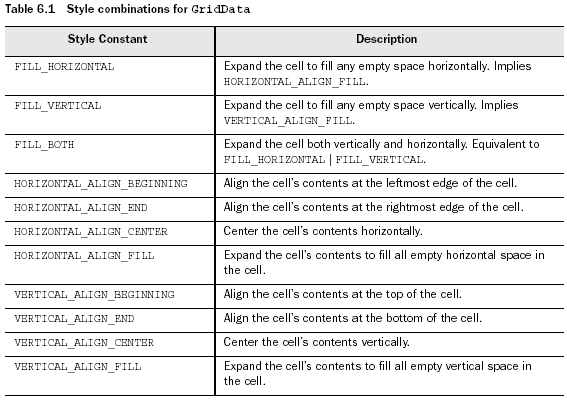
Using GridData size attributes
дёҺRowDataдёҚеҗҢеQҢGridDataҳqҳжңүеҫҲеӨҡзҡ„publicеұһжҖ§гҖӮе…¶дёӯжңүдәӣжҳҜеёғе°”еҖјзұ»еһӢзҡ„еQҢдёҖиҲ¬дјҡж ТҺҚ®жүҖи®„ЎҪ®зҡ„дёҚеҗҢstylesиҖҢиҮӘеҠЁз®ЎзҗҶпјҢжүҖд»Ҙж— йңҖеҜ№е…¶зӣҙжҺҘж“ҚдҪңгҖӮиҝҳжңүдёҖдәӣжҳҜintegerеҖы|јҢз”ЁжқҘјӢ®е®ҡеҚ•дёӘcellsзҡ„еӨ§һ®ҸгҖӮе…·дҪ“дҡgдёӢиЎЁеQ?br />
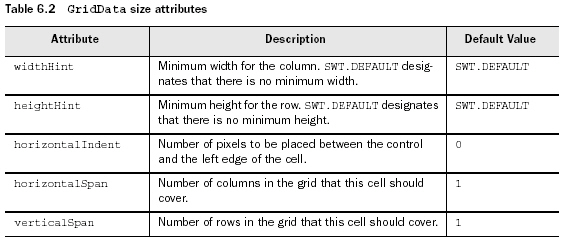
package com.swtjface.Ch6;
import org.eclipse.swt.*;
import org.eclipse.swt.widgets.*;
import org.eclipse.swt.layout.*;
public class Ch6RowLayoutComposite extends Composite {
public Ch6RowLayoutComposite(Composite parent) {
super(parent, SWT.NONE);
RowLayout layout = new RowLayout(SWT.HORIZONTAL);
setLayout(layout);
for (int i = 0; i < 16; ++i) {
Button button = new Button(this, SWT.NONE);
button.setText("Sample Text");
}
}
}
wrapвҖ”вҖ”й»ҳи®ӨдШ“true,иӢҘи®ҫдёәfalse,жүҖжңүзҡ„controlsйғҪеңЁеҗҢдёҖиЎҢгҖ?br />packвҖ”вҖ”й»ҳи®ӨдШ“true.дҪҝжүҖжңүзҡ„child controlsйғҪеӨ§һ®ҸдёҖж —чҖ?br />justifyвҖ”вҖ”й»ҳи®ӨдШ“false. иӢҘдШ“true,жҜҸдёҖиЎҢзҡ„controlйғҪдјҡд»Ҙй—ҙйҡ”зӣёеҗҢзҡ„ж–№ејҸжҺ’еҲ—гҖ?br />
RowData
еҸҜд»ҘйҖҡиҝҮsetLayoutData()жқҘи®ҫе®ҡжҜҸдёӘcontrolзҡ„еӨ§һ®ҸпјҢеҰӮпјҡbutton.setLayoutData(new RowData(200 + 5 * i, 20 + i));
package com.swtjface.Ch6;
import org.eclipse.swt.*;
import org.eclipse.swt.widgets.*;
import org.eclipse.swt.layout.*;
public class Ch6FillLayoutComposite extends Composite {
public Ch6FillLayoutComposite(Composite parent) {
super(parent, SWT.NONE);
FillLayout layout = new FillLayout( SWT.VERTICAL); //й»ҳи®ӨжҳҜSWT.HORIZONTAL
setLayout(layout);//дёәжӯӨCompositeи®‘Ц®ҡдёҖдёӘlayout.еҰӮжһңжјҸдәҶжӯӨиҜӯеҸҘпјҢдјҡжҳҫҪCЮZёҚеҮәchild controlгҖ?br />for (int i = 0; i < 8; ++i) {
Button button = new Button(this, SWT.NONE);
button.setText("Sample Text");
}
}
}
ProgressIndicator indicator = new ProgressIndicator(parent);
...
indicator.beginTask(10);
...
Display.getCurrent()display.asyncExec(new Runnable() {
public void run() {
//Inform the indicator that some amount of work has been done
indicator.worked(1);
}
});
жӯЈеҰӮдёҠдҫӢжүҖҪCәпјҢдҪҝз”ЁProgressIndicatorйңҖиҰ?жӯҘпјҡ
1.и®©indicatorзҹҘйҒ“жҖХd…ұжңүеӨҡһ®‘е·ҘдҪңпјҢйҖҡиҝҮдҪҝз”ЁbeginTask().еҸӘжңүҳqҷдёӘж–ТҺі•иў«и°ғз”ЁдәҶд№ӢеҗҺеQҢиҝҷдёӘcontrolжүҚдјҡеңЁеұҸтq•дёҠжҳ„ЎӨәгҖ?br />2.жҜҸеҪ“жңүдёҖйғЁеҲҶе·ҘдҪңиў«е®ҢжҲҗдәҶеQҢе°ұи°ғз”Ёworked()гҖӮдШ“дәҶйҳІжӯўйқһuiзҡ„зәҝҪEӢжқҘupdate widgetsеQҢжүҖд»ҘдӢЙз”ЁasyncExec()жқҘи§ЈеҶҢҷҝҷдёӘй—®йўҳгҖ?br />
ProgressIndicatorд№ҹжҸҗдҫӣanimatedжЁЎејҸеQҢеҚіжҖХd·ҘдҪңйҮҸдёҚзҹҘйҒ“зҡ„жғ…еҶөгҖӮеңЁҳqҷз§ҚжЁЎејҸдёӢпјҢthe bar continually fills and empties
until done() is called. иҰҒдӢЙз”ЁиҝҷдёӘжЁЎејҸпјҢһ®ЮpҰҒз”ЁbeginAnimatedTask()д»ЈжӣҝbeginTask();тq¶дё”дёҚйңҖиҰҒworked()ж–ТҺі•дә?/font>
//Style can be SMOOTH, HORIZONTAL, or VERTICAL
ProgressBar bar = new ProgressBar(parent, SWT.SMOOTH);
bar.setBounds(10, 10, 200, 32);
bar.setMaximum(100);
...
for(int i = 0; i < 10; i++) {
//Take care to only update the display from its
//own thread
Display.getCurrent().asyncExec(new Runnable() {
public void run() {
//Update how much of the bar should be filled in
bar.setSelection((int)(bar.getMaximum() * (i+1) / 10));
}
});
}
setSelection()causes the widget to be updated every time.This behavior is unlike that of ProgressIndicator or ProgressMonitorDialog,which will update the display only if it has changed by an amount that will be visible to the end user.
еҸҜйҖҡиҝҮsetMinimum()е’ҢsetMaximum()жқҘи®ҫе®ҡе®ғзҡ„иҢғеӣҙгҖӮеҸҜйҖҡиҝҮsetThumb()жқҘи®ҫе®ҡж»‘еқ—зҡ„еҖ№{ҖӮеңЁжңүдәӣOSдёҠпјҢthumbзҡ„еӨ§һ®ҸжҳҜеёёж•°гҖӮжҜҸжҢүдёҖдёӢз®ӯеӨЯ_јҢжүҖҝUХdҠЁзҡ„еҖјз§°дёәincrement.еҸҜйҖҡиҝҮsetIncrement()жқҘи®ҫе®ҡпјҢжҢүж»‘еқ—е’ҢҪҺӯеӨҙй—ҙзҡ„ҪIәй—ҙжүҖж»‘еҠЁзҡ„еҖйgШ“page incrementеQҢеҸҜйҖҡиҝҮPageIncrement()жқҘи®ҫе®ҡгҖӮд»ҘдёҠиҝҷдәӣж•°жҚ®еҸҜд»ҘйҖҡиҝҮvoid setValues( int selection, int minimum, int maximum, int thumb, int increment, int pageIncrement)жқҘдёҖӢЖЎжҖ§и®ҫе®ҡпјҢе…¶дёӯselectionжҳҜthumbзҡ„еҮәеҸ‘зӮ№гҖ?br />
SliderжңүдёӘеұһжҖ§з”ЁжқҘи®ҫе®ҡе…¶жҳҜж°ҙтqҢҷҝҳжҳҜеһӮзӣҙзҡ„еQҢй»ҳи®ӨдШ“ж°ҙег^гҖ?br />
package com.swtjface.Ch5;
import org.eclipse.swt.SWT;
import org.eclipse.swt.layout.FillLayout;
import org.eclipse.swt.widgets.Composite;
import org.eclipse.swt.widgets.Slider;
public class Ch5Slider extends Composite {
public Ch5Slider(Composite parent) {
super(parent, SWT.NONE);
setLayout(new FillLayout());
Slider slider = new Slider(this, SWT.HORIZONTAL);
slider.setValues(1000, 400, 1600, 200, 10, 100);
}
}
String[] coolItemTypes = {"File", "Formatting", "Search"};
CoolBar coolBar = new CoolBar(parent, SWT.NONE);
for(int i = 0; i < coolItemTypes.length; i++)
{
CoolItem item = new CoolItem(coolBar, SWT.NONE);
ToolBar tb = new ToolBar(coolBar, SWT.FLAT);
for(int j = 0; j < 3; j++)
{
ToolItem ti = new ToolItem(tb, SWT.NONE);
ti.setText(coolItemTypes[i] + " Item #" + j);
}
}
дҪ еҸҜйҖҡиҝҮи°ғз”ЁApplicationWindowзҡ„createToolBarManager()жқҘдШ“дҪ зҡ„еә”з”ЁҪEӢеәҸж·ХdҠ дёҖдёӘtoolbarгҖӮдёҺMenuManagerдёҚеҗҢзҡ„жҳҜеQҢcreateToolBarManager()йңҖиҰҒдёҖдёӘstyleеҸӮж•°еQҢиҝҷдёӘеҸӮж•°з”ЁжқҘи®ҫе®ҡToolBarжүҖз”Ёзҡ„жҢүй’®зҡ„йЈҺж ы|јҡflatжҲ–normalгҖ?/font>
- ControlContribution
йҷӨдәҶMenuManagerжүҖз”Ёзҡ„ContributionItemsд№ӢеӨ–еQҢиҝҳжңүдёҖдёӘж–°зҡ„ContributionItemеQҢеҸӘиғҪиў«ToolBarManagerдҪҝз”ЁвҖ”вҖ”ControlContributionгҖӮиҝҷдёӘзұ»еҸҜе°Ҷд»ЦMҪ•иғҪиў«з”ЁдәҺtoolbarзҡ„Controlжү“еҢ…ҳqӣеҺ»гҖ?br />
иҰҒдӢЙз”ЁControlContributionҫc»пјҢеҝ…йЎ»иҰҒе®һзҺ°жҠҪиұЎж–№жі•createControl().
toolBarManager.add(new ControlContribution("Custom") {
protected Control createControl(Composite parent) {
SashForm sf = new SashForm(parent, SWT.NONE);
Button b1 = new Button(sf, SWT.PUSH);
b1.setText("Hello");
Button b2 = new Button(sf, SWT.PUSH);
b2.setText("World");
b2.addSelectionListener(new SelectionAdapter() {
public void widgetSelected(SelectionEvent e) {
System.out.println("Selected:" + e);
}
});
return sf;
}
});
еҰӮжһңдҪ еёҢжңӣжңүд»ЦMҪ•зҡ„дәӢ件еҸ‘з”ҹпјҢеҝ…йЎ»еңЁдҪ зҡ„controlsдёҠе®һзҺ°SelectionListeners
- Creating toolbars by hand
еҰӮжһңдҪ дёҚжғіToolBarManagerжқҘеҲӣе»әtoolbarзҡ„иҜқеQҢеҸҜд»ҘжүӢеҠЁеҲӣе»әпјҢйңҖиҰҒз”ЁеҲ°ToolBarе’ҢToolItemҫc?
Toolbar
жҳҜдёҖдёӘcomposite controlеQҢеҢ…еҗ«еӨҡдёӘToolItems.Toolbarз”ұеӨҡдёӘе°Ҹеӣҫж ҮжҢүй’®ҫl„жҲҗеQҢдёҖиҲ¬жҳҜ16-by-16bitmapеӣ„ЎүҮгҖӮжҜҸдёӘжҢүй’®йғҪеҜ№еә”дёҖдёӘToolItemгҖӮToolbarеҸҜд»ҘжҳҜж°ҙтqізҡ„д№ҹеҸҜд»ҘжҳҜеһӮзӣҙзҡ„пјҢй»ҳи®Өдёәж°ҙтq?br />
ToolItem
жҜҸдёҖдёӘToolItemйғҪжңүдёҖдёӘеӣҫзүҮпјҢеҰӮжһңжІЎжңүеQҢй»ҳи®ӨдШ“ҫUўиүІж–№еқ—гҖӮWhen the user selects a ToolItem from the menu, it broadcasts the event to any registered SelectionListeners.Your application should register a listener with each ToolItem and use that listener to perform whatever logic corresponds to the menu item.
1.Simple:й»ҳи®ӨҫcХdһӢеQҢдёҖдёӘеҸҜҫ~–иҫ‘зҡ„text fieldе’ҢдёҖдёӘдҫӣйҖүжӢ©зҡ„list
2.Drop-down:дёӢжӢүеҲ—иЎЁеQҢж–Үжң¬жЎҶеҸҜзј–иҫ?br />3.Read-onlyеQҡж–Үжң¬жЎҶдёҚеҸҜҫ~–иҫ‘зҡ„дёӢжӢүеҲ—иЎЁпјҢеҸҜз”Ёselect( 0 )жқҘе°Ҷе…үҷ»ҳи®ӨйҖүдёӯеҲ—иЎЁдёӯзҡ„йҰ–йЎ№гҖ?br />
д»ҘдёҠдёүз§ҚҫcХdһӢеҸҜеңЁжһ„йҖ еҮҪж•оCёӯйҖҡиҝҮSTYLE.*жқҘи®ҫҫ|®гҖ?br />
- TextViewer and Document
дёӨдёӘйҮҚиҰҒзҡ„жҺҘеҸЈпјҡIDocumentе’ҢITextViewerгҖӮJFaceдёәе…¶жҸҗдҫӣдәҶй»ҳи®Өзҡ„е®һзҺ°гҖ?br />
дёҖдё?span lang="en-US">IDocumentзҡ„е®һдҫӢжҢҒжңүиў«ҫ~–иҫ‘зҡ„зңҹе®һзҡ„ж–Үжң¬дҝЎжҒҜгҖӮе®ғзҡ„дё»иҰҒе®һзҺ°жҳҜDocumentҫc…RҖӮAbstractDocumentжҸҗдҫӣдәҶйғЁеҲҶе®һзҺҺНјҢдҪ еҸҜйҖҡиҝҮҫl§жүҝе®ғжқҘж·ХdҠ иҮӘе·ұзҡ„е®һзҺ°гҖӮIDocumentе…Ғи®ёйҖҡиҝҮIDocumentListenerжҺҘеҸЈжқҘиҺ·еҸ–еҶ…е®№зј–иҫ‘зҡ„йҖҡзҹҘгҖ?br />
IDocumentҳqҳжҸҗдҫӣдәҶд»ҘдёӢеҠҹиғҪ
Positions
еҸҜд»ҘҫlҷжҜҸдёҖдёӘtextеҢәеҹҹеҲҶй…ҚдёҖдёӘи®°еҸдhқҘдҪңдШ“е®ғзҡ„PositionгҖӮеҪ“иў«жҢҮе®ҡз»ҷжҹҗдёӘducumentж—¶дёҖдёӘPositionеҜ№иұЎжңүan offset and a length of textгҖӮеҰӮжһңdocumentзҡ„textиў«жӣҙж–°зҡ„иҜқпјҢPositionд№ҹдјҡеҗҢжӯҘжӣҙж–°еQҢжүҖд»Ҙд»–ж°ёиҝңйғҪжҳҜжҢҮеҗ‘еҗҢдёҖҢDү|–Үеӯ—гҖӮPositionҫcАLң¬нw«жҸҗдҫӣдәҶдёҖдәӣеҹәжң¬зҡ„еҠҹиғҪеQҢеҸҜйҖҡиҝҮҫl§жүҝд»–жқҘе®Ңе–„жӣҙеӨҡжңүз”Ёзҡ„еҠҹиғҪгҖ?br />
Partition content types
жҜҸдёӘdocumentз”ЧғёҖдёӘжҲ–еӨҡдёӘpartitionsҫl„жҲҗеQҢйҖҡиҝҮITypedRegionжҺҘеҸЈжқҘиЎЁзҺ°гҖӮжҜҸдёҖдёӘpartitionеҸҜд»Ҙжңүеҗ„иҮӘзҡ„еҶ…е®№ҫcХdһӢеQҢеҰӮplain text, rich text, or HTMLгҖӮиҰҒдҪҝз”Ёе®ғпјҢдҪ иҰҒеҲӣеҫҸдёҖдёӘIDocumentPartitioner然еҗҺassignҫlҷдҪ зҡ„document,然еҗҺdocumentзҡ„partitionerһ®ЧғјҡиҙҹиҙЈе“Қеә”еҜТҺҢҮе®ҡдҪҚҫ|®еҶ…е®№зұ»еһӢзҡ„жҹҘиҜўеQҢе®ғеҝ…йЎ»йҖҡиҝҮе®һзҺ°computePartitioning()жқҘиҝ”еӣһеҢ…еҗ«жӯӨdocumentдёӯжүҖжңүITypedRegionsзҡ„дёҖдёӘж•°ҫl„гҖӮдёҚйңҖиҰҒе®һзҺоCҪ иҮӘе·ұзҡ„document partitionerгҖӮеҰӮжһңжІЎжңүеҲӣе»әпјҢж•ҙдёӘdocumentһ®ұжҳҜдёҖдёӘеҢәеҹҹпјҢҫcХdһӢдёәIDocument.DEFAULT_CONTENT_TYPEгҖ?br />
Searching
IDocumentйҖҡиҝҮsearch()жҸҗдҫӣдәҶжҗңзҙўзҡ„еҠҹиғҪгҖӮдёҚж”ҜжҢҒregular expressions or other patternsеQҢдҪҶжҸҗдҫӣдәҶsearch start location,direction, and case sensitivity and whether to match whole words only.
ITextViewerһ®ҶдёҖдёӘж ҮеҮҶзҡ„text widgetиҪ¬жҚўжҲҗдёҖдёӘеҹәдәҺdocumentзҡ„text widget
ITextViewerзҡ„й»ҳи®Өе®һзҺ°жҳҜTextViewerеQҢе®ғдҪҝз”ЁStyledTextжқҘжҳҫҪCәж•°жҚ®гҖӮITextViewerж”ҜжҢҒtext modificationsзҡ„listenerеQҢд№ҹж”ҜжҢҒvisual eventsеQҲеҰӮж”№еҸҳviewportеQҢеҚіtextзҡ„еҪ“еүҚеҸҜи§ҶеҢәеҹҹпјүзҡ„зӣ‘еҗ¬еҷЁгҖ?br />
иҷҪ然дҪңдШ“ITextViewerзҡ„й»ҳи®Өеә”з”ЁпјҢеҰӮжһңдҪ жғіиҰҒдҝ®ж”ТҺҳҫҪCәпјҢTextViewerе…Ғи®ёдҪ зӣҙжҺҘaccessStyledTextеQҢдҪҶе»шҷ®®дҪ дӢЙз”ЁTextPresentationеQҢеӣ дёәе®ғеҸҜд»Ҙж”үҷӣҶиҜҘж–ҮжЎЈдёӯеёҰжңүзҡ„еҗ„дёӘдёҚеҗҢзҡ„StyleRangesгҖ?br />
ITextViewerҳqҳж”ҜжҢҒеҫҲеӨҡдёҚеҗҢзұ»еһӢзҡ„жҸ’дҡgеQҢеҸҜз”ЁжқҘдҝ®ж”№widgetзҡ„иЎҢдёәгҖӮеҸҜд»Ҙиў«customizedзҡ„еҠҹиғҪжңүеQ?br />1.йҖҡиҝҮIUndoManagerжқҘж”ҜжҢҒundo
2.йҖҡиҝҮITextDoubleClickStrategyжқҘж”ҜжҢҒеҜ№йј ж ҮеҸҢеҮ»зҡ„еӨ„зҗ?br />3.йҖҡиҝҮIAutoIndentStrategyжқҘж”ҜжҢҒж–Үжң¬зҡ„иҮӘеҠЁҫ~©иҝӣ
4.йҖҡиҝҮITextHoverжқҘе®һзҺҺНјҢеҪ“йј ж ҮеҒңз•ҷеңЁdocumentзҡ„дёҖдёӘsectionдёҠж—¶еQҢжҳҫҪCәtext.
иҰҒдӢЙз”ЁдёҠҳq°жҸ’д»УһјҢдҪ йңҖиҰҒеҲҶй…ҚдёҖдёӘйҖӮеҪ“зҡ„жҺҘеҸЈе®һдҫӢз»ҷtext viewerеQҢ然еҗҺи°ғз”ЁactivatePlugins().
еҰӮдёӢеҲ—еҮәдәҶorg.eclipse.jface.textзҡ„еӯҗеҢ…еҸҠе…¶дҪңз”?br />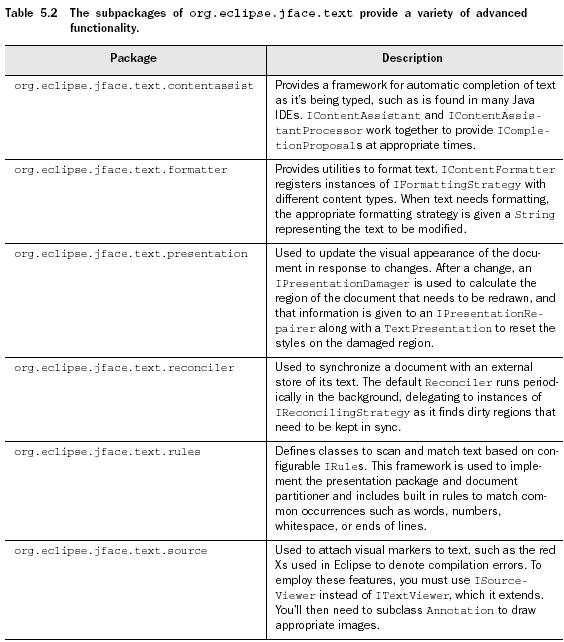
- The basic Text widget
package com.swtjface.Ch5;
import org.eclipse.swt.SWT;
import org.eclipse.swt.events.VerifyEvent;
import org.eclipse.swt.events.VerifyListener;
import org.eclipse.swt.layout.FillLayout;
import org.eclipse.swt.widgets.Composite;
import org.eclipse.swt.widgets.Text;
public class Ch5Capitalizer extends Composite {
public Ch5Capitalizer(Composite parent) {
super(parent, SWT.NONE);
buildControls();
}
private void buildControls() {
this.setLayout(new FillLayout());
Text text = new Text(this, SWT.MULTI | SWT.V_SCROLL);
text.addVerifyListener(new VerifyListener() { //жҜҸеҪ“textиў«ж”№еҸҳпјҢд»ЦMҪ•д»ҘжіЁеҶҢзҡ„VerifyListenersдҫҝдјҡиў«и°ғз”ЁгҖӮжӯӨеӨ„жҜҸжҢүдёҖӢЖЎй”®зӣҳпјҢжӯӨж–№жі•е°ұиў«и°ғз”ЁгҖӮеҰӮжһңжҳҜеҗҢж—¶иҫ“е…ҘеӨҡдёӘеӯ—з¬ҰеQҢд№ҹи°ғз”ЁдёҖӢЖ?/font>
public void verifyText(VerifyEvent e) {
if( e.text.startsWith("1") ) {
e.doit = false;
} //еҰӮжһңж–Үжң¬д»?ејҖеӨЯ_јҢеҚідёҚе…Ғи®ёҫ~–иҫ‘
else {
e.text = e.text.toUpperCase();
}
}
});
}
}
Textзҡ„йҮҚиҰҒж–№жі•пјҢи§ҒдёӢеӣ?br />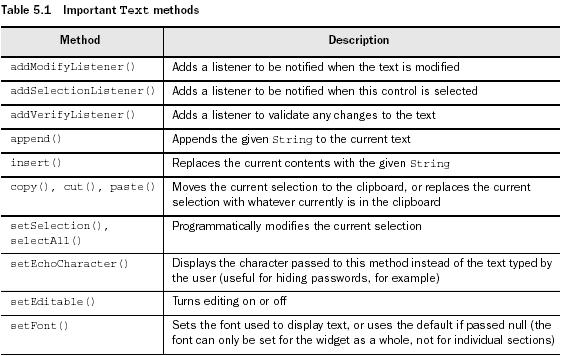
insert()--doesnвҖҷt allow you to insert text into the existing content.
- The StyledText widget
StyledTextеҢ…еҗ«дәҶдёҖҫpХdҲ—зҡ„еә”з”ЁеҲ°иҜҘе°ҸйғЁдҡgзҡ„йў„е®ҡд№үзҡ„еҠЁдҪңпјҢҳqҷдәӣжҳҜ常规зҡ„дёңиҘҝеҰӮпјҡеүӘеҲҮгҖҒзІҳиҙҙгҖҒ移еҠЁиҮідёӢдёҖдёӘиҜҚгҖҒ移еҠЁиҮіж–Үжң«гҖӮд»ЈиЎЁиҝҷдәӣеҠЁдҪңзҡ„её”RҮҸең?/span>org.eclipse.swt.customҪEӢеәҸеҢ…дёӯзҡ?/span>STҫcЦMёӯжңүе®ҡд№үгҖӮиҝҷдәӣеёёйҮҸеңЁдёӨз§Қжғ…еҶөдёӢеҸ‘жҢҘеҠҹж•ҲпјҡйҰ–е…ҲеQҢдҪ еҸҜд»ҘдҪҝз”Ёе®ғ们ҪEӢеәҸжҖ§ең°дҪҝз”ЁinvokeAction()ж–ТҺі•и°ғз”Ёд»ЦMёҖзҡ„иҝҷдәӣж–№жі•пјӣе…¶ж¬ЎеQҢдҪ д№ҹеҸҜд»ҘдӢЙз”?/span>setKeyBinding()ж–ТҺі•жқҘе°Ҷе®ғ们ҫl‘е®ҡдәҺй”®еҮ»иЎҢдёәгҖ?/span>setKeyBinding()йҖүе®ҡдёҖдёӘй”®еQҲеҸҜд»ҘйҖҡиҝҮиҜёеҰӮShiftжҲ–жҳҜCtrlд№Ӣзұ»зҡ„зј–иҫ‘й”®жқҘдҝ®ж”?/span>SWTеё”RҮҸд№ӢдёҖеQүз»‘е®ҡдәҺжҢҮе®ҡзҡ„еҠЁдҪңгҖӮеҰӮдёӢзҡ„дҫӢеӯҗдёӯз»„еҗҲй”®Ctrl-Qҫl‘е®ҡдәҺзІҳиҙҙеҠЁдҪңгҖӮеј•иөдhіЁж„Ҹзҡ„жҳҜиҝҷтq¶дёҚж„Ҹе‘ізқҖдјҡе°Ҷй»ҳи®Өй”®зҡ„ҫl‘е®ҡжё…йҷӨеQҢиҜҘдёӨдёӘҫl‘е®ҡйғҪдјҡз”ҹж•ҲгҖ?/span>
зӣёеҜ№дәҺTextиҖҢиЁҖеQҢиҝҳж·ХdҠ дәҶdrawing line backgrounds and line stylesзҡ„дәӢд»УһјҢеҸҜд»ҘйҖҡиҝҮжӯӨдәӢ件жқҘж”№еҸҳж•ҙиЎҢзҡ„styleжҲ–иғҢжҷҜйўңиүҢУҖӮжіЁж„ҸпјҡеҰӮжһңдҪҝз”ЁдәҶLineStyleListener,һ®ЧғёҚиғҪеңЁStyledTextе®һдҫӢдёҠи°ғз”Ёget/setStyleRange()еQ?еҰӮжһңдҪҝз”ЁдәҶLineBackgroundListenerеQҢйӮЈдҪ е°ұдёҚиғҪи°ғз”ЁgetLineBackground() or setLineBackground().
еҸҜд»ҘйҖҡиҝҮдҪҝз”ЁдёҖдёӘStyledTextзҡ„StyleRangesжқҘж”№еҸҳжҳҫҪCәзҡ„йЈҺж ј
StyleRange
StyledTextйҖҡиҝҮдҪҝз”ЁStyleRangeҫcАLқҘҪҺЎзҗҶеҪ“еүҚжүҖжҳ„ЎӨәзҡ„дёҚеҗҢstylesгҖӮе…¶жүҖжңүзҡ„ж ҸдҪҚйғҪжҳҜpublicзҡ„еҸҜйҡҸж„Ҹдҝ®ж”№еQҢдҪҶжҳҜиҰҒдёҖзӣҙеҲ°еҪ“жӯӨStyledTextе®һдҫӢзҡ„setStyleRange()иў«и°ғз”Ёд№ӢеҗҺжүҚдјҡз”ҹж•ҲгҖ?br />
StyleRangesйҖҡиҝҮејҖе§ӢеҒҸҝU»йҮҸе’Ңй•ҝеәҰжқҘи®‘Ц®ҡtextзҡ„еҢәеҹҹиҢғеӣҙгҖ?/font>
StyleRangeеҸҜи®ҫе®ҡиғҢжҷҜе’ҢеүҚжҷҜиүФҢјҢй»ҳи®ӨдёәnullеQҢиҝҳеҸҜи®ҫе®ҡеӯ—дҪ“пјҢSWT.NORMAL жҲ–иҖ…SWT.BOLD.
similarTo()еҸҜз”ЁжқҘеҲӨж–ӯдёӨдёӘStyleRangeе®һдҫӢжҳҜеҗҰжңүеҗҢж пLҡ„еүҚжҷҜгҖҒиғҢжҷҜе’Ңеӯ—дҪ“гҖ?br />
еҪ“жҲ‘们дҝқеӯҳtextд№ӢеҗҺеQҢеҸҜйҖҡиҝҮstyledText.getStyleRanges()жқҘиҺ·еҸ–styleдҝЎжҒҜеQҢжӯӨеҮҪж•°дјҡиҝ”еӣһan array of StyleRange
toggleBold()--һ®Ҷе·Іиҫ“е…Ҙзҡ„ж–Үжң¬еңЁboldе’Ңnormalд№Ӣй—ҙеҲҮжҚўеQҢжҳҜиў«дёҖдёӘKeyListenerи°ғз”Ёзҡ„пјҢжӯӨKeyListenerдјҡзӣ‘еҗ¬F1жҳҜеҗҰиў«жҢүдё?br />
A StyledText example
еӨҚеҲ¶гҖҒзІҳиҙҙеҠҹиғҪдёҚйңҖиҰҒйҖҡиҝҮд»Јз ҒдҫҝеҸҜдҪҝз”ЁеQҢжҳҜе’Ңplatformзҡ„ж ҮеҮҶй”®зӣҳеҝ«жҚдh–№ејҸзӣёе…ҢҷҒ”зҡ?br />
ExtendedModifyListenerе’ҢModifyListenerдёҚеҗҢеQҢеүҚиҖ…жҸҗдҫӣдәҶе…ідәҺwhat was doneзҡ„eventҫlҶиҠӮеQҢиҖҢеҗҺиҖ…еҸӘжҳҜеҪ“ҫ~–иҫ‘жҮӮдҪңдә§з”ҹж—¶notify,дёҚдјҡеҺХdҮҶјӢ®зҡ„иҫЁеҲ«еҲ°еә•дҪ•з§Қдҝ®ж”№еҸ‘з”ҹдәҶгҖ?br />
package com.swtjface.Ch5;
import java.util.LinkedList;
import java.util.List;
import org.eclipse.swt.SWT;
import org.eclipse.swt.custom.*;
import org.eclipse.swt.events.KeyAdapter;
import org.eclipse.swt.events.KeyEvent;
import org.eclipse.swt.layout.FillLayout;
import org.eclipse.swt.widgets.Composite;
public class Ch5Undoable extends Composite {
private static final int MAX_STACK_SIZE = 25;
private List undoStack;
private List redoStack;
private StyledText styledText;
public Ch5Undoable(Composite parent) {
super(parent, SWT.NONE);
undoStack = new LinkedList();
redoStack = new LinkedList();
buildControls();
}
private void buildControls() {
this.setLayout(new FillLayout());
styledText = new StyledText(this, SWT.MULTI | SWT.V_SCROLL);
styledText.addExtendedModifyListener(
new ExtendedModifyListener() { //жҜҸж¬Ўtextиў«зј–иҫ‘зҡ„ж—¶еҖҷпјҢйғҪдјҡи°ғз”ЁжӯӨlistener
public void modifyText(ExtendedModifyEvent event) {
String currText = styledText.getText();
String newText = currText.substring(event.start,
event.start + event.length); //иҺ·еҫ—ж–°жҸ’е…Ҙзҡ„ж–Үжң¬
if( newText != null && newText.length() > 0 ) {
if( undoStack.size() == MAX_STACK_SIZE ) {
undoStack.remove( undoStack.size() - 1 );
}
undoStack.add(0, newText);//һ®Ҷж–°жҸ’е…Ҙзҡ„ж–Үжң¬дҝқеӯҳеҲ°undoStackдё?/font>
}
}
}); //е…ій”®йғЁеҲҶ
styledText.addKeyListener(new KeyAdapter() {
public void keyPressed(KeyEvent e) {
switch(e.keyCode) {
case SWT.F1:
undo(); break;
case SWT.F2:
redo(); break;
default: //ignore everything else
}
}
});
}
private void undo() {
if( undoStack.size() > 0 ) {
String lastEdit = (String)undoStack.remove(0);//еҫ—еҲ°иҰҒundoзҡ„еӯ—ҪW?/font>
int editLength = lastEdit.length();
String currText = styledText.getText();
int startReplaceIndex = currText.length() - editLength;
styledText.replaceTextRange(startReplaceIndex, editLength, ""); //һ®ҶжңҖеҗҺиҫ“е…Ҙзҡ„еӯ—з¬ҰжӣҝжҚўжҲҗз©ә
redoStack.add(0, lastEdit);//жҠҠжңҖеҗҺзҡ„ҳqҷдёӘundoзҡ„еӯ—ҪWҰеҠ еҲ°redoStackдё?/font>
}
}
private void redo() {
if( redoStack.size() > 0 ) {
String text = (String)redoStack.remove(0);//еҫ—еҲ°иҰҒжҒўеӨҚзҡ„еӯ—з¬Ұ
moveCursorToEnd();
styledText.append(text);//һ®ҶиҰҒжҒўеӨҚзҡ„еӯ—ҪWҰеҠ иҮПx–Үжң¬зҡ„жңҖеҗ?/font>
moveCursorToEnd();
}
}
private void moveCursorToEnd() {
styledText.setCaretOffset(styledText.getText().length());
}
}
Action--еӨ„зҗҶдәӢдҡg
дёҺSWTзҡ„listener/eventжЁЎејҸеҫҲзұ»дјы|јҢдҪҶжҳҜе…¶classжӣҙжҠҪиұЎпјҢжӣҙжҳ“дәҺдӢЙз”ЁпјҢscopeжӣҙзӘ„гҖ?/font>
- actions and contributions
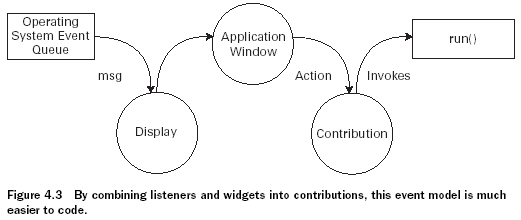
Action--еҸҜд»ҘҪҺҖеҚ•зҡ„зҗҶи§ЈжҲҗдёҖдёӘе‘Ҫд»ӨпјҢеҸҜд»Ҙе…ҢҷҒ”еҲ°иҸңеҚ•пјҢе·Ҙе…·жқЎпјҢд»ҘеҸҠжҢүй’®
Contribution--ең?/span>JFaceйҮҢйқўеQҢдёҖдё?/span>ActionеҸҜд»ҘеҜ№еә”еӨҡдёӘGUIеҜ№иұЎеQҢиҝҷдәӣеҜ№иұЎе°ұжҳҜжүҖи°“зҡ„Contribution Item. жңүдёӨдёӘдё»иҰҒзҡ„Contributionҫc»пјҡContributionItemе’ҢContributionManagerеQҢе®ғ们йғҪжҳҜжҠҪиұЎзұ»еQҢйқ е…¶еӯҗҫcАLқҘе®һзҺ°дәӢдҡgзҡ„еӨ„зҗҶгҖӮз‘фжүҝе…іҫp»и§ҒдёӢеӣҫ
ContributionItem--еј•еҸ‘дәӢдҡgзҡ„еҚ•зӢ¬GUIҫl„дҡg
ContributionManager--дә§з”ҹеҢ…еҗ«ContributionItemsзҡ„еҜ№иұ?br />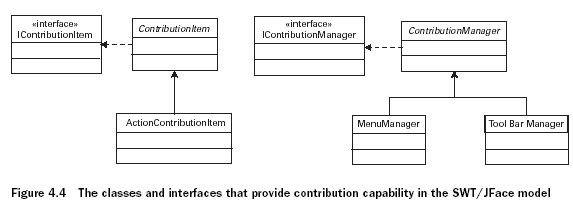
ActionContributionItem--жңҖйҮҚиҰҒеQҢеңЁApplicationWindowдёӯеҲӣе»әе’Ңе®һж–ҪеQҢжқҘһ®ҶдёҖдёӘactionҳqһжҺҘиҮПxӯӨGUIеQҢе®ғиҷҪжІЎжңүи®ҫе®ҡеҘҪзҡ„еӨ–и§ӮпјҢдҪҶжҳҜдҫқиө–дәҺдҪ дҪҝз”Ёзҡ„fill()ж–ТҺі•еQҢеҚҙеҸҜд»Ҙеё®еҠ©дёҖдёӘжҢүй’®гҖҒиҸңеҚ•ж Ҹе’Ңе·Ҙе…дh Ҹзҡ„жҲҗеҪ?br />
еҸҰдёҖдёӘдёҺContributionеҚҸдҪңзҡ„ж–№жі•жҳҜйҖҡиҝҮContributionManager,е®ғзҡ„еӯҗзұ»ҫcЦMјјдәҺContributionItemзҡ„containerгҖӮе…¶дёӯMenuManagerһ®ҶContributionItemsҫl„еҗҲеңЁзӘ—еҸЈжңҖй«ҳеұӮиҸңеҚ•еQ?ToolBarManagerеҲҷе°ҶҳqҷдәӣеҜ№иұЎж”‘ЦңЁд»…еңЁиҸңеҚ•д№ӢдёӢзҡ„toolbarдёӯгҖ?/font>
- еҲӣеҫҸActionҫc?/font>
ActionжҳҜжҠҪиұЎзұ»гҖ?/font>
package com.swtjface.Ch4;
import org.eclipse.jface.action.*;
import org.eclipse.jface.resource.*;
public class Ch4_StatusAction extends Action
{
StatusLineManager statman;
short triggercount = 0;
public Ch4_StatusAction(StatusLineManager sm)
{
super("&Trigger@Ctrl+T",
AS_PUSH_BUTTON);//еңЁTеӯ—жҜҚд№ӢеүҚзҡ?amp;ҪWҰеҸ·ж„Ҹе‘ізқҖҳqҷдёӘеӯ—жҜҚһ®ҶдҪңдёшҷҜҘеҠЁдҪңзҡ„еҝ«жҚ·й”®гҖӮиҖҢеңЁTEXTйўҶеҹҹеҶ…зҡ„вҖңCtrl+TвҖқзЎ®дҝқдәҶеҪ“з”ЁжҲ·еңЁеҗҢж—¶жҢүдёӢCtrlй”®е’ҢTй”®ж—¶иҜҘеҠЁдҪңе°ұдјҡиў«ӢИҖеҸ‘гҖ?/font>
statman = sm;
setToolTipText("Trigger the Action");
setImageDescriptor(ImageDescriptor.createFromFile
(this.getClass(),"eclipse.gif"));
}
public void run() //жҜҸж¬ЎеҪ“Ch4_StatusActionиў«з”ҹжҲҗпјҢrun()ж–ТҺі•һ®Юpў«и°ғз”Ё
{
triggercount++;
statman.setMessage("The status action has fired. Count: " +
triggercount);
}
- Implementing contributions in an ApplicationWindow
package com.swtjface.Ch4;
import org.eclipse.swt.*;
import org.eclipse.swt.widgets.*;
import org.eclipse.jface.window.*;
import org.eclipse.jface.action.*;
public class Ch4_Contributions extends ApplicationWindow {
StatusLineManager slm = new StatusLineManager();
Ch4_StatusAction status_action = new Ch4_StatusAction(slm); //з”?font face="Verdana">StatusLineManagerзҡ„еҜ№иұЎдҪңеҸӮж•°еQ?/font>еҲӣеҫҸдәҶдёҖдё?font face="Verdana">Ch4_StatusActionзҡ„е®һдҫ?/font>
ActionContributionItem aci = new ActionContributionItem(status_action); //з”?font face="Verdana" size="2">Ch4_StatusActionзҡ„еҜ№иұЎдҪңеҸӮж•°еQҢеҲӣе»ЮZәҶActionContributionItemеҜ№иұЎ
public Ch4_Contributions() {
super(null); // еҲӣеҫҸдә?/font> ApplicationWindowеҜ№иұЎ
addStatusLine();
addMenuBar();
addToolBar(SWT.FLAT | SWT.WRAP); //еңЁзӘ—еҸЈдёҠж·ХdҠ дәҶstatus line, menu, toolbar
}
protected Control createContents(Composite parent) {
getShell().setText("Action/Contribution Example");
parent.setSize(290,150); //и®„ЎҪ®дәҶзӘ—еҸЈзҡ„titleе’Ңsize
aci.fill(parent); // һ®ҶActionContributionItemж”‘ЦңЁGUIдёӯгҖӮеӣ дёшҷҝҷйҮҢзҡ„еҸӮж•°жҳҜCompositeеҜ№иұЎеQҢжүҖд»Ҙж №жҚ®Actionзҡ„STYLEеұһжҖ§жқҘјӢ®е®ҡгҖӮжӯӨеӨ„жҳҜButtonеQҢеӣ дё?font color="#0000ff">Ch4_StatusAction зҡ„STYLEеұһжҖ§жҳҜAS_PUSH_BUTTON;
return parent;
}
public static void main(String[] args) {
Ch4_Contributions swin = new Ch4_Contributions();
swin.setBlockOnOpen(true);
swin.open();
Display.getCurrent().dispose();
}
protected MenuManager createMenuManager() {
MenuManager main_menu = new MenuManager(null);
MenuManager action_menu = new MenuManager("Menu");
main_menu.add(action_menu);
action_menu.add(status_action); //е…ҢҷҒ”status_action.created and added to the menu in the form of a menu item
return main_menu;
}
protected ToolBarManager createToolBarManager(int style) {
ToolBarManager tool_bar_manager = new ToolBarManager(style);
tool_bar_manager.add(status_action); //е…ҢҷҒ”status_actionгҖӮcreated and added to the toolbar as a toolbar item.
return tool_bar_manager;
}
protected StatusLineManager createStatusLineManager() {
return slm;
}
}
- Interfacing with contributions
дёӨдёӘйҖ”еҫ„жқҘе°ҶActionContributionItemж·ХdҠ еҲ°GUIеQ?br />1. йҖҡиҝҮContributionManagerеӯҗзұ»зҡ„add()ж–ТҺі•гҖ?br />еQ?еQүеҸҜжҺҘеҸ—ActionеҜ№иұЎзҡ„еҸӮж•ҺНјҢд»ҺиҖҢй—ҙжҺҘзҡ„һ®ҶContributionItemе’ҢContributionManagerе…ҢҷҒ”гҖӮеҸҜеӨҡж¬Ўжү§иЎҢ
еQ?еQүеҸҜзӣҙжҺҘжҺҘеҸ—ActionContributionItemеҜ№иұЎзҡ„еҸӮж•°гҖӮеҸӘеҸҜжү§иЎҢдёҖӢЖ?br />2.йҖҡиҝҮActionContributionItemҫcИқҡ„fill()ж–ТҺі•гҖӮж №жҚ®е…¶еҸӮж•°зҡ„дёҚеҗҢпјҢжүҖе…ҲжҳҜзҡ„组件д№ҹдёҚеҗҢеQҢе…·дҪ“и§ҒдёӢиЎЁеQ?br />method.jpg)
- Exploring the Action class
Important methods of the Action class
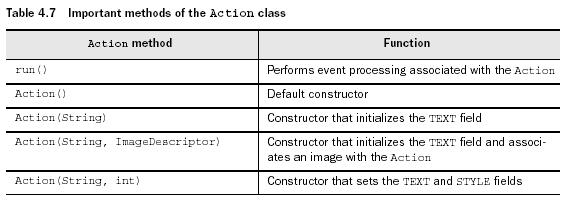
Property methods for the Action class
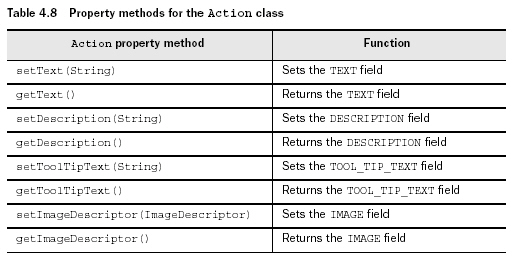
DESCRIPTION--written to a status line to provide additional help.
Style methods for the Action class
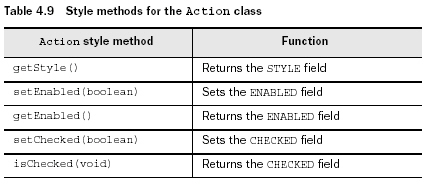
еҰӮжһңENABLEDжҳҜFALSEеQҢеҲҷеҸҳзҒ°гҖӮCHECKEDдё»иҰҒз”ЁдәҺradioе’Ңcheckbox
Accelerator key / keyboard methods for the Action class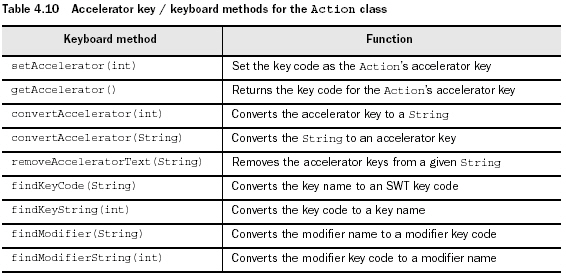
Accelerator keys--йј ж ҮзӮ№еҮ»зҡ„й”®зӣҳеқ—жҚдh–№еј?/font>
Listener methods for the Action class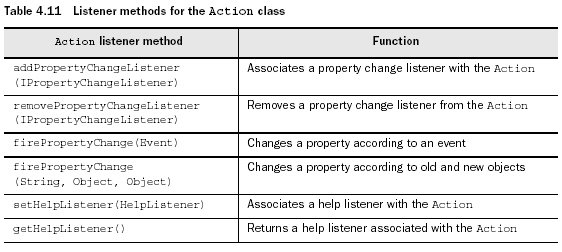
иҷҪ然JFaceдҪҝз”Ёactionд»ЈжӣҝдәҶSWTзҡ„listener/eventжңәеҲ¶еQҢдҪҶжҳҜActionoҫcЦM»Қ然еҸҜд»Ҙе’ҢlistenerеҚҸдҪңжқҘеӨ„зҗҶзү№е®ҡйңҖжұӮзҡ„дәӢдҡgгҖ?br />IPropertyChangeListenerжҺҘеҸЈе…ПxіЁе®ўжҲ·иҮӘе®ҡд№үзҡ„PropertyChangeEvents,еҪ“жүҖҫlҷзҡ„еҜ№иұЎжҢүз…§дҪ жүҖҫlҷзҡ„ж–№ејҸеҸҳжҲҗеҸҰдёҖдёӘеҜ№иұЎж—¶еQҢжӯӨдәӢдҡgиў«и§ҰеҸ‘гҖ?br />
Miscellaneous methods of the Action class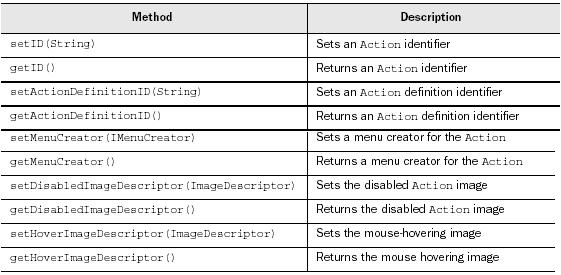

1. Once an SWT application begins running, its Display class sorts through this queue using its readAndDispatch() method and msg field, which acts as a handle to the underlying OS message queue.
2. If it finds anything relevant, it sends the event to its top-level Shell object, which determines which widget should receive the event.
3. The Shell then sends the event to the widget that the user acted on, which transfers this information to an associated interface called a listener.
4. One of the listenerвҖҷs methods performs the necessary processing or invokes another method to handle the userвҖҷs action, called an event handler.
жүҖеңЁеҢ…еQҡorg.eclipse.swt.events
В В
- typed listeners and events
typed listeners--еҸӘеҜ№жҹҗдёҖҫcИқҡ„з”ЁжҲ·дәӢдҡgиө·дҪңз”ЁпјҢҫl§жүҝTypedListenerҫc?br />typed events--дёҺжӯӨҫcИқү№е®ҡеҠЁдҪңзӣёе…ізҡ„дәӢдҡgеQҢз‘фжүҝTypedEventҫc?br />
еҸҜйҖҡиҝҮadd...Listener()method with the typed listener as the argumentжқҘе°Ҷlistenerйҷ„еҠ еҲ°widgetгҖ?br />
е®Ңж•ҙзҡ„typed eventsе’ҢlistenersеҲ—иЎЁеQҢеҰӮдёӢпјҡ В
В
TypedEventҫcХdҢ…еҗ«дәҶдёҖдәӣmember field,他们жҸҗдҫӣдёҺдәӢ件еҸ‘з”ҹзӣёе…ізҡ„дёҖдәӣдҝЎжҒҜпјҢҳqҷдәӣдҝЎжҒҜеҸҜд»ҘеңЁevent handlerдёӯдӢЙз”ЁжқҘиҺ·еҫ—дёҺзҺҜеўғзӣёе…ізҡ„дҝЎжҒҜгҖӮдёӢеӣҫдШ“ҫl§жүҝиҮӘTypedEventеҸҠEventObjectҫcИқҡ„fields: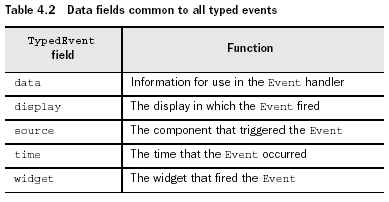
йҷӨжӯӨд№ӢеӨ–еQҢеҫҲеӨҡзҡ„eventҫc»иҝҳжңүе…¶д»–з”ЁжқҘжҸҗдҫӣжӣҙеӨҡз”ЁжҲ·еҠЁдҪңдҝЎжҒҜзҡ„fields,еҰӮMouseEventҫcИқҡ„button field
иҰҒе°ҶlistenerеҠ е…ҘеҲ°codeдёӯпјҢжңүдёӨдёӘдё»иҰҒзҡ„ж–ТҺі•еQ?br />ҪW¬дёҖдёӘжҳҜеңЁcomponentзҡ„add...Listener()дёӯеҲӣе»ЮZёҖдёӘеҢҝеҗҚжҺҘеҸЈпјҢҳqҷж ·еҸҜд»ҘдҪҝlistenerзҡ„дҪңз”Ёеҹҹд»…йҷҗдәҺжӯӨcomponent,ҪCЮZҫӢд»Јз ҒеҰӮдёӢеQ?br />Button button = new Button(shell, SWT.PUSH | SWT.CENTER);//еҲӣеҫҸдәҶдёҖдёӘbuttonеQҢеЖҲһ®Ҷе…¶еҠ е…ҘеҲ°shellдё?br />button.addMouseListener(new MouseListener() //еҲӣеҫҸдәҶдёҖдёӘеҢҝеҗҚMouseListenerжҺҘеҸЈеQҢеЖҲһ®Ҷе…¶дёҺbuttonе…ҢҷҒ”
{
public void mouseDown(MouseEvent e)
{
clkdwnEventHandler();
}
public void mouseUp(MouseEvent e)
{
clkupEventHandler();
}
public void mouseDoubleClick(MouseEvent e)
{
dblclkEventHandler(); //жӯӨжҺҘеҸЈдёӯеҝ…йЎ»иў«е®һзҺ°зҡ„дёүдёӘж–ТҺі•гҖӮдёҖж—Ұйј ж ҮжҢүдёӢпјҢж”‘ЦјҖжҲ–еҸҢеҮ»пјҢһ®ЧғјҡжңүдёҖдёӘMouseEventиў«еҸ‘йҖҒеҲ°ҳqҷдёүдёӘж–№жі•дёӯзҡ„дёҖдёӘпјҢ然еҗҺеQҢжӯӨж–ТҺі•еҶҚи°ғз”Ёзӣёе…ҢҷҒ”зҡ„event-handlingж–ТҺі•еQҲеҚідёӢж–Үдёӯзҡ„дёүдёӘеQүгҖ?/font>
}
});
static void dblclkEventHandler()
{
System.out.println("Double click.");
}
static void clkdwnEventHandler()
{
System.out.println("Click - down.");
}
static void clkupEventHandler()
{
System.out.println("Click - up.");//event-handlersйҖҡиҝҮеҸ‘йҖҒmessageеҲ°consoleжқҘе®ҢжҲҗдәӢ件еӨ„зҗ?/font>
}
дёҠдёҖҫcАL–№жі•зҡ„ҫ~әзӮ№жҳҜжӯӨlistenerд»…йҷҗдәҺжӯӨcomponentеҶ…пјҢиҖҢ第дәҢз§Қж–ТҺі•дҫҝеҸҜи§ЈеҶіҳqҷз§Қй—®йўҳ--зӢ¬з«Ӣзҡ„еЈ°жҳҺдёҖдёӘз‘фжүҝMouseListenerзҡ„жҺҘеҸЈпјҢҪCЮZҫӢд»Јз ҒеҰӮдёӢеQ?br />Button button = new Button(shell, SWT.PUSH | SWT.CENTER);
button.addMouseListener(ExampleMouseListener);
MouseListener ExampleMouseListener = new MouseListener()
{
public void mouseDoubleClick(MouseEvent e)
{
System.out.println("Double click.");
}
public void mouseDown(MouseEvent e)
{
System.out.println("Click - down.");
}
public void mouseUp(MouseEvent e)
{
System.out.println("Click - up.");
}
};
дҪҝз”ЁMouseListenerзҡ„зјәзӮ№е°ұжҳҜе“ӘжҖ•дҪ еҸӘе…іеҝғйј ж ҮеҸҢеҮЦMәӢд»УһјҢеҚҙд»ҚиҰҒеЈ°жҳҺе…¶жҺҘеҸЈдёӯжүҖеҢ…еҗ«зҡ„жүҖжңүж–№жі•гҖ?/font>В
- Adapter
AdapterжҳҜз‘фжүҝдәҶListenerжҺҘеҸЈтq¶жҸҗдҫӣдәҶжүҖжңүrequiredж–ТҺі•зҡ„е®һзҺ°зҡ„abstractҫc…RҖӮд№ҹһ®ұжҳҜиҜҙеҰӮжһңдҪ дҪҝз”ЁadapterиҖҢдёҚжҳҜlistenerзҡ„иҜқеQҢдҪ еҸӘйңҖиҰҒеҶҷдҪ ж„ҹе…ҙи¶Јзҡ„ж–№жі?br />
еҸӘжңүйӮЈдәӣlistenerжңүеӨҡдёӘжҲҗе‘ҳж–№жі•зҡ„eventжүҚжңүadapter,е…¶е®Ңж•ҙеҲ—иЎЁи§ҒдёӢеӣҫеQ?br />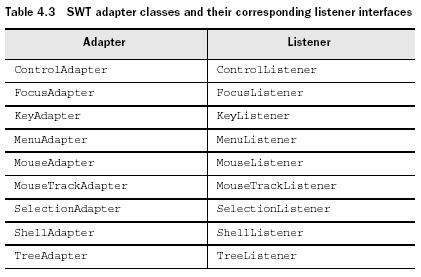
adapterеҗҢж ·жҳҜйҖҡиҝҮadd...Listener()ж–ТҺі•жқҘеҲӣе»әзҡ„еQҢдёҺlistenerҫcЦMјјеQҢеҗҢж ·д№ҹеҸҜйҖҡиҝҮеҢҝеҗҚҫcХd’Ңжң¬ең°ҫcЦMёӨҝUҚж–№жі•пјҢдёӢдҫӢдёәеҢҝеҗҚзұ»ж–ТҺі•еQ?br />button.addMouseListener(new MouseAdapter()
{
public void mouseDoubleClick(MouseEvent e)
{
dblclkEventHandler();
}
)};
static void dblclkEventHandler()
{
System.out.println("Double click.");
}
- Keyboard events
д»ЦMҪ•ж—¶еҖҷеҸӘиҰҒkeyиў«жҢүдёӢпјҢһ®ЧғјҡеҲӣеҫҸKeyEventеQҢе®ғжңүдёӨдёӘеӯҗҫc»пјҡTraverseEvent е’ҢVerifyEvent.
TraverseEvent--еҪ“жҢүдёӢarrow keyжҲ–tab keyжқҘfocus on text widgetж—?br />VerifyEvent--fires when the user enters text that the program needs to check before taking further action.
йҷӨдәҶҫl§жүҝиҮӘTypedEventе’ҢEventObjectзҡ„field,KeyEventҳqҳеҢ…жӢ¬дёүдёӘmember fieldжқҘжҸҗдҫӣйӮЈдәӣдёҺи§ҰеҸ‘дәӢдҡgзҡ„keyзӣёе…ізҡ„дҝЎжҒҜпјҢе…·дҪ“еҰӮдёӢеQ?br />character--д»ЈиЎЁиў«жҢүдёӢkeyзҡ„char
stateMask--Returns an integer representing the state of the keyboard modifier keys.By examining this integer, a program can determine whether any of the Alt, Ctrl, Shift, and Command keys are currently pressed.
keyCode--Provides the SWT public constant corresponding to the typed key. KeyCodeеҲ—иЎЁеQҢи§ҒдёӢеӣҫеQ?br />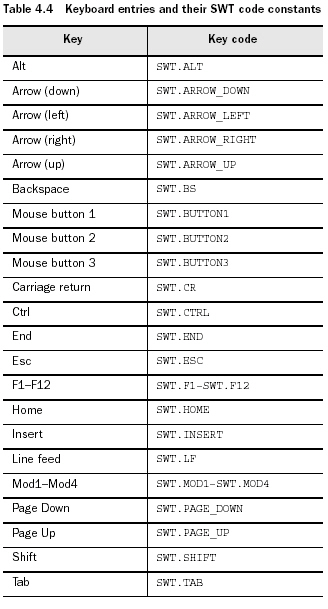
TraverseEventдёӯжңүдёӨдёӘfields:
1. doit--ҳq”еӣһеёғе°”еҖы|јҢиӢҘдШ“зңҹеҲҷе…Ғи®ёеңЁеҗ„дёӘcomponentй—ҙеҲҮжҚўfocus,иӢҘдШ“еҒҮеҲҷдёҚе…Ғи®ёеҲҮжҚўfocus
2. detail--ItвҖҷs an integer that represents the identity of the key that caused the event. For example, if the user presses the Tab key to switch to a new component, the detail field will contain the SWT constant TRAVERSE_TAB_NEXT.
жҜҸдёӘҫcХdһӢзҡ„ControlеҜ№дәҺжүҖҫlҷзҡ„traversal keyйғҪжңүдёҚеҗҢзҡ„й»ҳи®ӨbehaviorеQҢеҰӮжһңи®ҫdoitдёәtrueеQҢеҲҷoverrideдәҶе…¶й»ҳи®Өзҡ„и®ҫҫ|®гҖ?br />
VerifyEventзҡ„field:
1.startе’Ңend--и®‘Ц®ҡдәҶиҫ“е…Ҙзҡ„иҢғеӣҙ
2.text--contains the input String under examination.
3.doit--Having looked at the userвҖҷs text, you set the boolean doit field to allow (TRUE) or disallow (FALSE) the action.
- untyped events
жӣҙзҒөӢz»пјҢдҪҶдёҚе®үе…ЁеQҢдёҚжҺЁиҚҗдҪҝз”ЁгҖ?br />еҪ“дёҖдёӘд»ЈиЎЁзқҖйқһзұ»еһӢеҢ–зӣ‘еҗ¬еҷЁзҡ„зӣ‘еҗ¬еҷЁзұ»е’ҢGUIзҡ„жҹҗдёҖҫl„дҡgзӣёиҒ”ҫpАL—¶еQҢе®ғһ®ЮpғҪжҺҘеҸ—иҜҘ组件жүҖиғҪеҸ‘йҖҒзҡ„д»ЦMёҖҫcЦMәӢ件гҖӮеӣ жӯӨпјҢдҪ йңҖиҰҒж“ҚжҺ§иҝҷз”ұEventҫcЦM»ЈиЎЁзҡ„жҚ•иҺ·зҡ„е…ЁйғЁдәӢд»УһјҢеҶӣ_®ҡз”ЁжҲ·жү§иЎҢзҡ„йӮЈдёӘеҠЁдҪңгҖӮ然еҗҺпјҢжӯЈзЎ®зҡ„дәӢ件еӨ„зҗҶж–№жі•е°ұиў«и°ғз”ЁгҖ?br />
дёҚжҳҜиў«еҢ…еҗ«еңЁorg.eclipse.swt.eventsеҢ…дёӯеQҢиҖҢжҳҜиў«еҢ…еҗ«еңЁorg.eclipse.swt.widgetsеҢ…дёӯгҖ?br />
д»Јз ҒҪCЮZҫӢеҰӮдёӢеQ?br />Listener listener = new Listener ()
{
public void handleEvent (Event event)
{
switch (event.type)
{
case SWT.KeyDown:
if (event.character == 'b')
System.out.println("Key"+event.character);
break;
case SWT.MouseDown:
if (event.button == 3)
System.out.println("Right click");
break;
case SWT.MouseDoubleClick:
System.out.println("Double click");
break;
}
}
};
Button button = new Button(shell, SWT.CENTER);
button.addListener(SWT.KeyDown, listener);
button.addListener(SWT.MouseDown, listener);
button.addListener(SWT.MouseDoubleClick, listener);
EventҫcХdҢ…еҗ«дәҶжүҖжңүtyped eventдёӯзҡ„жүҖжңүfield,жӯӨеӨ–ҳqҳжңүдёҖдёӘtype fieldеQҢе…¶жүҖжңүзҡ„еҖјеҲ—иЎЁеҰӮдёӢпјҡ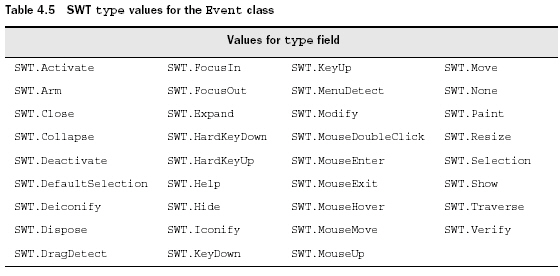
getChildren()
lists the children of a Composite as an array of Control objects.
getLayout()гҖҒsetLayout(Layout)
еӨ„зҗҶlayoutеҜ№иұЎ
getTabList()гҖҒsetTabList(Control[])
жҢҮе®ҡwidgetsеңЁCompositeдёӯзҡ„TabҷеәеәҸеQҲжҢүй”®зӣҳtabй”®зҡ„еҲҮжҚўҷеәеәҸеQ?br />
CompositeҫcАLҳҜScrollableҫcИқҡ„зӣҙжҺҘеӯҗзұ»еQҢиҝҷһ®ұжҳҜиҜҙSWT/JFaceдёӯзҡ„жүҖжңүCompositeеҜ№иұЎйғҪжңүScrollbars.жүҖжңүзҡ„ScrollableеҜ№иұЎйғҪеҸҜдҪҝз”ЁеҰӮдёӢж–ТҺі•еQ?br />getClientArea()гҖ?computeTrim(int, int,int, int)
trim--Compositeзҡ„дёҚеҸҜзј–иҫ‘еҢәеҹҹпјҢеҰӮtitle bars, scrollbars, жҲ–status barsҪ{?
client area--йӮЈдәӣеҸҜзј–иҫ‘пјҢдҪҝз”Ёзҡ„еҢәеҹ?br />getClientArea()--Returns the available display area of a Scrollable object
computeTrim(int,int,int,int)--Returns the necessary dimensions of the Composite for the desired client area
getHorizontalBar()гҖҒgetVerticalBar()
Returns the horizontal/vertical ScrollBar object
Control, Scrollable, and Compositeзҡ„е…іҫp»пјҢеҰӮдёӢеӣ?br />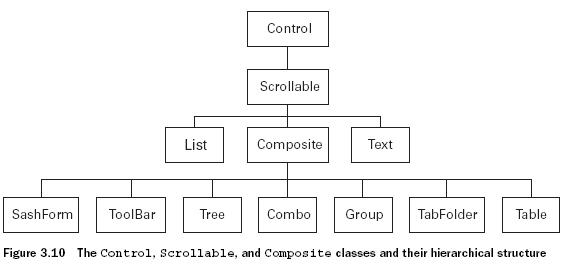 В В
В В
- Groups
Compositeеӯҗзұ»дёӯжңҖҪҺҖеҚ•зҡ„дёҖдёӘпјҢиҮӘинnдёҚжү§иЎҢд“QдҪ•еҠЁдҪңпјҢд»…д»…жҳҜе°ҶдёҖҫl„еӯҗwidgetsз”Ёзҹ©еҪўиҫ№жЎҶи“vжқҘпјҢжӯӨиҫ№жЎҶзұ»дјйgәҺд№ӢеүҚжҸҗеҲ°зҡ„еҲҶйҡ”з¬ҰеQҢеҗҢж ·д№ҹжҸҗдҫӣSWT.SHADOW_IN, SWT.SHADOW_OUT, SWT.SHADOW_NONEйЈҺж јеQҢиҝҳеҸҜд»ҘйҖҡиҝҮйҖүжӢ©SWT.SHADOW_ETCHED_IN or SWT.SHADOW_ETCHED_OUTжқҘе®ўеҲ¶еҢ–йҳҙеӘ„ж•ҲжһңгҖ?br />
еҸҜд»ҘйҖҡиҝҮsetText()ж–ТҺі•жқҘи®ҫе®ҡе®ғзҡ„label
дёҺи®ёеӨҡWidgetsеӯҗзұ»дёҖж шPјҢGroupҫcЦMёҚеҸҜиў«ҫl§жүҝгҖ?/font>
- SashForms
еҸҜд»ҘеңЁеӯҗwidgetsд№Ӣй—ҙеҲӣеҫҸеҸҜ移еҠЁзҡ„еҲҶз•ҢеQҢжӯӨеҲҶз•ҢҝUоCШ“Sash.SashҫcХdҸҜд»ҘеңЁorg.eclipse.swt.widgetsеҢ…дёӯжү‘ЦҲ°еQҢиҖҢSashFormsеҚҙеӯҳеңЁдәҺorg.eclipse.swt.customеҢ…дёӯгҖ?br />
SWT.HORIZONTALе’ҢSWT.VERTICAL--з”ЁжқҘи®‘Ц®ҡSashзҡ„ж–№еҗ?br />setOrientation()--з”ЁжқҘи®‘Ц®ҡSashзҡ„ж–№еҗ?br />getMaximizedControl()--returns the Control object that has been expanded the most.
getWeights()--returns an int array containing the weight of each of the SashFormвҖҷs children.uses an int array to specify weights for each of the widgets in the Composite.
- TabFolders
creating and populating a TabFolderзҡ„еӣӣдёӘжӯҘйӘӨпјҡ
1.В еҲӣеҫҸдёҖдёӘTabFolderе®һдҫӢ
2. дёәжҜҸдёӘйЎөйқўжһ„е»ЮZёҖдёӘTabItemеҜ№иұЎ
3. з”ЁsetText()ж–ТҺі•жқҘи®ҫе®ҡtabзҡ„label
4. setControl()--е…ҢҷҒ”дёҖдёӘcontrolеQҢеҪ“е®ғзҡ„tabиў«йҖүдёӯж—УһјҢжҳ„ЎӨәжӯӨcontrol
TabFolderҫcАLҸҗдҫӣдәҶдёҖдәӣз”ЁжқҘиҺ·еҫ—TabItemsдҝЎжҒҜзҡ„ж–№жі•пјҢеҰӮдёӢеQ?br />getItemCount()
ҳq”еӣһжӯӨTabFolderжүҖеҢ…еҗ«зҡ„TabItemsж•?br />getItems()
ҳq”еӣһTabItemsеҜ№иұЎзҡ„ж•°ҫl?br />getSelection()
јӢ®е®ҡuserйҖүжӢ©дәҶе“ӘдёӘTabItem
setSelection()
Makes this decision from within the application
ButtonҫcИқҡ„й»ҳи®ӨйЈҺж јгҖ?br />SWT.FLAT
- SWT.ARROW
дёҺSWT.UP, SWT.DOWN, SWT.LEFT, and SWT.RIGHTҫl„еҗҲеQҢд№ҹеҸҜдӢЙз”ЁSWT.FLAT
- SWT.TOGGLE
ҫcЦMјјдәҺSWT.PUSHеQҢдҪҶжҳҜжҢүдёӢеҗҺдјҡдҝқжҢҒжҢүдёӢзҠ¶жҖҒгҖӮеҸҜйҖҡиҝҮsetSelection(boolean)ж–ТҺі•жқҘж”№еҸҳе…¶зҠ¶жҖҒгҖӮжҺҘдёӢеҺ»д»Ӣз»Қзҡ„checkжҢүй’®е’ҢradioжҢүй’®д№ҹshareҳqҷдёӘеҠҹиғҪ
- SWT.CHECK
е»шҷ®®з”Ёж•°ҫl„жқҘе®һзҺ°,еҰӮдёӢеQ?br />Button[] checks = new Button[2];
checks[0] = new Button(shell, SWT.CHECK);
checks[0].setText("Choice 1");
checks[0].setLocation(10,5);
checks[0].pack();
checks[1] = new Button(shell, SWT.CHECK);
checks[1].setText("Choice 2");
checks[1].setLocation(10,30);
checks[1].pack();
- SWT.RADIO
е»шҷ®®з”Ёж•°ҫl„жқҘе®һзҺ°,еҰӮдёӢеQ?/font>
Button[] radios = new Button[3];
radios[0] = new Button(shell, SWT.RADIO);
radios[0].setSelected(true);
radios[0].setText("Choice 1");
radios[0].setLocation(10,5);
radios[0].pack();
radios[1] = new Button(shell, SWT.RADIO);
radios[1].setText("Choice 2");
radios[1].setLocation(10,30);
radios[1].pack();
radios[2] = new Button(shell, SWT.RADIO);
radios[2].setText("Choice 3");
radios[2].setLocation(10,55);
radios[2].pack();
for (int i=0; i<radios.length; i++)
if (radios[i].getSelected())
System.out.println(i);
йҖҡиҝҮRadioGroupFieldEditorsһ®Ҷradio buttonsҫl„еҗҲеңЁдёҖиө?
RadioGroupFieldEditor rgfe = new RadioGroupFieldEditor(
"UserChoice", "Choose an option:", 1,
new String[][] {{"Choice1", "ch1"},
{"Choice2", "ch2"},
{"Choice3", "ch3"}},
shell, true);
е…¶дёӯзҡ„еҗ„дёӘеҸӮж•°еҗ«д№үеҰӮдёӢвҖ”вҖ?.name for the type of value returned by the editor.2.group label.3.еҲ—ж•°гҖ?.creates a set of option names with their associated values.In this manner, the RadioGroupFieldEditor can display a series of radio buttons without allocating Button objects.5.һ®ҶeditorеҠ иҮіShellеҜ№иұЎгҖ?.specifies whether the radio buttons should be incorporated in a Group object.
еңЁSWT/JFaceдё?container widgetsжҳҜз”ұCompositeҫcАLқҘжҸҗдҫӣзҡ„гҖ?/font>
- йЈҺж је’ҢеҲҶйҡ”з¬Ұ
еҜҡwҪҗж–№ејҸеQҡSWT.CENTER,SWT.LEFT, and SWT.RIGHT.
еҲҶйҡ”ҪWҰпјҡSWT.SEPARATOR;SWT.VERTICAL, SWT.HORIZONTAL;SWT.SHADOW_IN, SWT.SHADOW_OUT, and SWT.SHADOW_NONE.
- Labelзҡ„ж–№жі?/font>
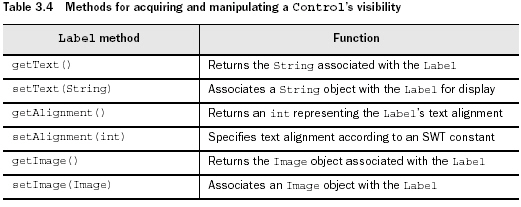
жҳҜжүҖжңүwidgetзҡ„зҲ¶ҫc…RҖӮдШ“жҠҪиұЎҫc»пјҢиҖҢдё”Eclipse.orgд№ҹејәзғҲеҸҚеҜ№еҺ»ҫl§жүҝе®ғпјҢеӣ жӯӨдҪ ж—ўдёҚиғҪҫl§жүҝд»–пјҢд№ҹдёҚиғҪзӣҙжҺҘдӢЙз”Ёе®ғ
WidgetҫcЦMёӯзҡ„йҮҚиҰҒж–№жі•пјҢеҰӮдёӢеQ?/font>

- Control objects
ControlҫcЦMёӯзҡ„еҜ№иұЎеңЁOSдёӯжңүдёҖдёӘзӣҙжҺҘзҡ„еүҜжң¬еQҢдҪ еҸҜд»ҘйҖҡиҝҮҫcИқҡ„handle fieldжқҘзӣҙжҺҘaccess.然иҖҢSWTҳqҳжҸҗдҫӣдәҶдёҖдәӣеңЁControlҫcЦM№ӢеӨ–зҡ„widgets,еҰӮдёӢжүҖҪCәпјҡ
 В
В
ControlҫcИқҡ„дёӨзұ»ж–ТҺі•еQ?/font>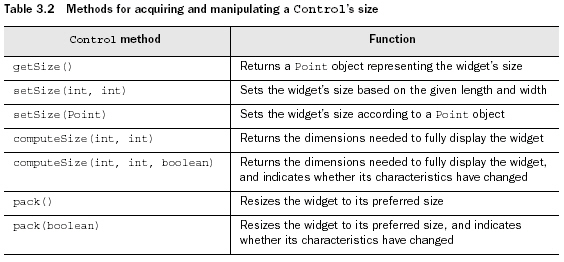
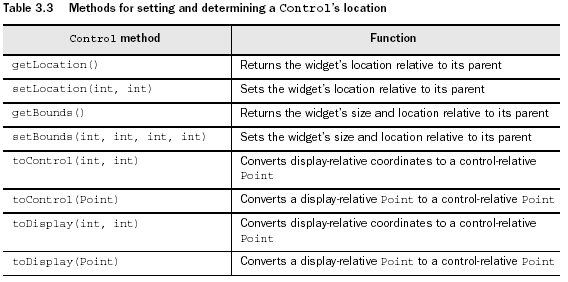
дёҺSWT widgetsдёҖиө·е·ҘдҪңзҡ„JFaceҫcХdҸҜҝUоCШ“model-based adapters [жҲ–helper classes].ҳqҷдәӣadapterеҸҜд»ҘеҲҶдШ“4ҫc»пјҡ
1.Viewers
һ®ҶGUIҫl„дҡgдёӯзҡ„дҝЎжҒҜдёҺеӨ–и§ӮеҲҶјӣ?[дёҺSWTдёҚеҗҢ]
2.Actions and contributions
ҪҺҖеҢ–дәҶдәӢдҡgзҡ„еӨ„зҗҶпјҢһ®Ҷз”ЁжҲ·е‘Ҫд»Өзҡ„еҸҚеә”дёҺеј•еҸ‘еҸҚеә”зҡ„дәӢдҡgеҲҶзҰ»
3.Image and font registries
жіЁеҶҢжңәеҲ¶еQ?span id="BlogViewId">иө„жәҗеҸҜд»Ҙиў«жҢүйңҖеҲҶй…Қе’ҢйҮҠж”?/span>
4.Dialogs and wizards
дҝЎжҒҜжЎҶгҖҒй”ҷиҜҜжЎҶгҖҒиҝӣеәҰжЎҶдёҺеҗ‘еҜјжЎҶҪ{?/font>
- SET/JFaceеә”з”ЁҪEӢеәҸзҡ„дёүҢDөејҸҫl“жһ„
package com.swtjface.Ch2;
import org.eclipse.jface.window.*;
import org.eclipse.swt.*;
import org.eclipse.swt.widgets.*;
public class HelloSWT_JFace extends ApplicationWindow {
public HelloSWT_JFace() {
super(null); //1.Window allocation
}
protected Control createContents(Composite parent) {
Text helloText = new Text(parent, SWT.CENTER);
helloText.setText("Hello SWT and JFace!");
parent.pack();
return parent; //2.Window presentation
/*еӨ„зҗҶҪH—еҸЈзҡ„и®ҫи®?з”ЧғәҺApplicationWindowзҡ„еҸҜи§ҶйғЁеҲҶдёҚиғҪиў«зӣҙжҺҘaccessеQҢжӯӨж–ТҺі•ҳqһеҗҢдёҖдёӘCompositeжқҘжҺ§еҲ¶GUIзҡ„жҳҫҪCәпјҢжӯӨcontainerеҜ№иұЎ[Composite]жҳҜжүҖжңүиў«еҠ е…Ҙеә”з”ЁҪEӢеәҸзҡ„GUIҫl„дҡgзҡ„зҲ¶д»?/font>*/
}
public static void main(String[] args) {
HelloSWT_JFace awin = new HelloSWT_JFace();
awin.setBlockOnOpen(true);
awin.open();
Display.getCurrent().dispose();В //3.Window operation
/*иҙҹиҙЈGUIзҡ„е®һйҷ…иҝҗдҪңгҖӮеңЁеҲҶжҙҫеҘҪApplicationWindowзҡ„иө„жәҗд№ӢеҗҺпјҢmainж–ТҺі•дҪҝзӘ—еҸЈжҳҫҪCәпјҢеҪ“setBlockOnOpen()ж–ТҺі•д»ҘдёҖдёӘtrueеҸӮж•°иў«и°ғз”Ёзҡ„ж—¶еҖҷпјҢҪH—еҸЈе…ій—ӯгҖӮ然еҗҺApplicationWindowзҡ„open()ж–ТҺі•иў«и°ғз”ЁпјҢж ТҺҚ®createContent()ж–ТҺі•жүҖҳq”еӣһзҡ„CompositeжқҘжҳҫҪCәзӘ—еҸЈгҖӮ然еҗҺзЁӢеәҸйҖҡиҝҮdispose()ж–ТҺі•йҮҠж”ҫGUIзҡ„Displayе®һдҫӢ.еӣ дШ“жӯӨзЁӢеәҸдёӯзҡ„жүҖжңүwidgetйғҪжҳҜdisplayзҡ„childеQҢжүҖд»ҘдёҖж—ҰйҮҠж”ҫDisplayеQҢжүҖжңүзҡ„widgetйғҪиў«йҮҠж”ҫ*/
}
}
- SWTдёҺSWT/JFaceзҡ„еҢәеҲ?/strong>
SWTһ®ҶGUIзҡ„еӨ–и§Ӯе’Ңж“ҚдҪңйғҪж”ҫеңЁе®ғзҡ„Shellҫc»йҮҢеQҢиҖҢSWT/JFaceеҚҙе°ҶдёӨиҖ…еҲҶјӣХdјҖжқҘдәҶеQҢе…¶дёӯеӨ–и§Ӯз”ұcreateContents()ж–ТҺі•еҶ…зҡ„CompsiteжқҘжҺ§еҲУһјҢиҖҢж“ҚдҪңйғЁеҲҶеӨ§дҪ“дёҠжҳҜйҖҡиҝҮApplicationWindowҫcИқҡ„е®һдҫӢжқҘе®һзҺ°зҡ„гҖ?/font>
- ApplicationWindow
SWT/JFaceеҗҢж ·йңҖиҰҒдёҖдёӘеҚ•зӢ¬зҡ„Displayе®һдҫӢеQҢдҪҶжҳҜеҸӘиҰҒApplicationWindowйҖҡиҝҮдёҖдёӘnullеҸӮж•°жқҘжһ„е»әпјҢйӮЈд№Ҳһ®ЧғјҡеҲӣеҫҸе®ғиҮӘе·Юqҡ„ShellгҖӮеҸӮйҳ…дёӢеӣ?br />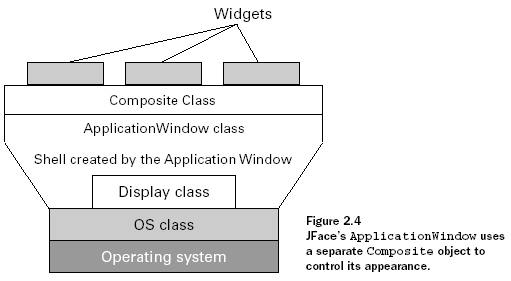
ApplicationWindowеңЁShellзҡ„еҹәјӢҖдёҠжҸҗдҫӣдәҶжӣҙеӨҡзҡ„йҖ”еҫ„жқҘи®ҫи®ЎзӘ—еҸЈпјҢе…¶зӣёе…Пx–№жі•еҰӮдёӢпјҡ
addMenuBar()
Configures the window with a top-level menu
addToolBar()
Adds a toolbar beneath the main menu
addStatusLine()
Creates a status area at the bottom of the window
setStatus(String)
Displays a message in the status area
getSeparator()
Returns the line separating the menu from the window
setDefaultImage(Image)
Displays an image when the application has no shell
setExceptionHandler(IExceptionHandlerеQ?/u>
Configures the application to handle exceptions according to the specified interface
package com.swtjface.Ch2;
import org.eclipse.swt.*;
import org.eclipse.swt.widgets.*;
public class HelloSWT {
public static void main (String [] args) {
Display display = new Display();
Shell shell = new Shell(display); //1.Allocation and initializationгҖ?br />/*з”ҹжҲҗдёҖдё?font size="2">Displayе’?/font>ShellҫcИқҡ„е®һдҫӢеQ?span id="BlogViewId">GUIиҺ·еҸ–еә•еұӮтqӣ_Ҹ°зҡ„иө„жәҗеЖҲејҖиҫҹдәҶдёҖдёӘдё»ҪH—еҸЈгҖ?/
Text helloText = new Text(shell, SWT.CENTER);
helloText.setText("Hello SWT!");
helloText.pack();//2.Adding widgets to the shell
/*
ең?/font>
Shell
дёҠеҠ е…ҘдёҖдёӘж–Үжң¬е°ҸйғЁдҡgгҖӮThe code in this section also sets the parameters for these widgets, containers, and events to make sure they look and act as required.е…¶дёӯpack()ж–ТҺі•жҳҜtell the Shell and Text components to use only as much space as they need.*/
shell.pack();
shell.open();
while (!shell.isDisposed()){
if (!display.readAndDispatch()) display.sleep();
}
display.dispose(); //3.GUI operation
/*дёҖж—ҰShellзҡ„open()ж–ТҺі•иў«и°ғз”?еә”з”ЁҪEӢеәҸзҡ„дё»ҪH—еҸЈе’Ңе…¶еӯҗйғЁд»үҷғҪдјҡиў«е‘ҲзҺ°гҖӮеҸӘиҰҒShellдҝқжҢҒеңЁжү“ејҖзҠ¶жҖҒпјҢDisplayе®һдҫӢһ®ЧғјҡйҖҡиҝҮе®ғзҡ„readAndDispatch()ж–ТҺі•жқҘиҝҪнt?span id="BlogViewId">еңЁж“ҚдҪңзі»ҫlҹдәӢд»үҷҳҹеҲ—дёӯзҡ„зӣёе…із”ЁжҲ·дәӢ件гҖӮеҪ“ҪH—еҸЈе…ій—ӯж—УһјҢдё?/font>DisplayеҜ№иұЎеQҲеҢ…жӢ?/font>Shellд»ҘеҸҠе…¶еӯҗйғЁдҡgҪ{үпјүзӣёиҒ”ҫpИқҡ„иө„жәҗһ®ұе…ЁйғЁйҮҠж”?/font>*/
}
}
- Display ҫc?/strong>
Display ҫcХdЖҲдёҚжҳҜеҸҜи§Ғзҡ„пјҢдҪҶе®ғиҙҹиҙЈзӣ‘з®ЎзқҖ GUI зҡ„иө„жәҗеЖҲҪҺЎзҗҶзқҖе’Ңж“ҚдҪңзі»ҫlҹзҡ„йҖҡдҝЎгҖ?span id="BlogViewId">е®ғдёҚе…үиҰҒе…ПxіЁзқҖе®ғиҮӘе·Юqҡ„ҪH—еҸЈжҳҜеҰӮдҪ•жҳҫҪCәгҖҒ移еҠЁе’ҢйҮҚз”»зҡ„пјҢҳqҳеҗҢж—¶иҰҒјӢ®дҝқиҜёеҰӮйј ж ҮзӮ№еҮ»гҖҒй”®зӣҳж•ІеҮИқӯүдәӢдҡgйҖҒиҫҫwidgetsтq¶еҺ»еӨ„зҗҶе®ғ们гҖ?/font>
жҳҜд“QдҪ?/font>
SWT
е’?/font>
JFace
еә”з”ЁҪEӢеәҸзҡ„жүҝиҪҪзқҖеQҢж— и®ЮZҪ жҳҜз”Ё
SWT/JFace
ејҖеҸ‘жҲ–жҳҜеҚ•з”?/font>
SWT
ејҖеҸ‘пјҢдҪ еҝ…ҷеХdңЁдҪ зҡ„ҪEӢеәҸдёӯеҢ…еҗ«иҝҷдёӘзұ»зҡ„дёҖдёӘе®һдҫӢгҖ?br />
Display
ҫcИқҡ„дё»иҰҒд»ХdҠЎһ®ұжҳҜиҙҹиҙЈһ®ҶдҪ зҡ„д»Јз ҒйҮҚзҡ?/span>
SWT
е’?/span>
JFace
е‘ҪдЧoҫҳ»иҜ‘жҲҗеә•еұӮзҡ„е‘ҪдЧoжқҘи°ғеҸ–ж“ҚдҪңзі»ҫlҹгҖ?/font>
ҳqҷдёҖҳqҮзЁӢеҢ…еҗ«дәҶдёӨйғЁеҲҶеQ?/font>
1.Display
еҜ№иұЎжһ„еҫҸдёҖдёӘд»ЈиЎЁзқҖж“ҚдҪңҫpИқ»ҹтqӣ_Ҹ°зҡ?/font>
OS
ҫcИқҡ„е®һдҫӢеQӣиҝҷдёӘзұ»йҖҡиҝҮдёҖҫpХdҲ—иў«з§°д№ӢдШ“native methodsзҡ„зү№ҢD?/font>
Java
ҪEӢеәҸжҸҗдҫӣдәҶжҺҘи§Ұи®ЎҪҺ—жңәеә•еұӮиө„жәҗзҡ„йҖ”еҫ„гҖ?.
ҳqҷдёӘ
Display
еҜ№иұЎдҪҝз”Ёҳqҷдәӣж–ТҺі•жқҘзӣҙжҺҘжҢҮд»Өж“ҚдҪңзі»ҫlҹеЖҲеҗ‘еә”з”ЁзЁӢеәҸдј иҫ„Ў”ЁжҲ·еҠЁдҪңгҖ?br />
if any features in your operating system arenвҖҷt incorporated into SWT, you can use the Java Native Interface to add them yourself.All it requires is a native Java method in the SWT package and a C function in the native graphics library that calls the operating system.
- Display ҫcИқҡ„ж–ТҺі•
1.Display()--Allocates platform resources and creates a Display object
must be used in any SWT-based GUI.е®ғдс”з”ҹдёҖдёӘDisplayҫcИқҡ„е®һдҫӢтq¶е°Ҷе…¶е’ҢGUIзӣёиҒ”ҫp?/font>
2.getCurrent()--Returns the user-interface thread
must be used in any SWT-based GUI.е®ғиҝ”еӣһдёҖдёӘеә”з”ЁзЁӢеәҸзҡ„дёИқәҝҪEӢпјҢз”ЁжҲ·з•ҢйқўҫUҝзЁӢ,йҖҡеёёе’Ңdispose()дёҖиө·дӢЙз”ЁжқҘҫl“жқҹDisplayзҡ„ж“ҚдҪңгҖ?/font>
3.readAndDispatch()--Display object interprets events and passes them to receiver
enable the application to receive notifications from the operating system whenever the user takes an action associated with the GUI.
accesses the operating systemвҖҷs event queue and determines whether any of the userвҖҷs actions are related to the GUI.
Using this method, the HelloSWT class knows whether the user has decided to dispose of the Shell. If so, the method returns TRUE, and the application ends. Otherwise, the Display object invokes its sleep() method, and the application continues waiting.
4.sleep()--Display object waits for events
enable the application to receive notifications from the operating system whenever the user takes an action associated with the GUI.
The Shell class accesses the operating system through the OS class to an extent, but only to keep track of opening, activating, maximizing, minimizing, and closing the main window.
The main function of the Shell class is to provide a common connection point for the containers, widgets, and events that need to be integrated into the GUI. Shell serves as the parent class to these components.
attached to the Displayзҡ„shell--top-level shells
NOT directly attached to the Display instanceзҡ„shell--secondary shell
еңЁдҪ зҡ?/font>GUIд№ӢеҶ…еQҢдҪ еҸҜд»Ҙи®‘Ц®ҡshellжҲ–е…¶д»–е°ҸйғЁдҡgзҡ„йЈҺж јеҸӮж•°еҖы|јҢиӢҘжҳҜеӨҡдёӘеҖјеҲҷеҸҜд»Ҙз”ЁвҖ?/font>|вҖ?/font>зӣёиҝһ.йҷӨдәҶжҸҗеҲ°зҡ„еұһжҖ§пјҢй»ҳи®ӨдёәвҖ?span id="BlogViewId">SHELL_TRIMвҖқгҖ?br />
SHELL_TRIM--жңүдёҖдёӘж Үйўҳж Ҹ(SWT.TITLE)е’Ңз”ЁжҲ·еҸҜд»ҘжңҖһ®ҸеҢ–SWT.MIN)гҖҒжңҖеӨ§еҢ–(SWT.MAX)гҖҒж”№еҸҳе°әеҜ?/font>(SWT.RESIZE)е’Ңе…ій—?/font>(SWT.CLOSE)
DIALOG_TRIM--жңүдёҖдёӘж Үйўҳж ҸгҖҒдёҖдёӘжҙ»еҠЁеҢәзҡ„иҫ№з•?/font>(SWT.BORDER)е’Ңиў«е…ій—ӯзҡ„иғҪеҠ?/font>
дҪ иҝҳеҸҜд»ҘјӢ®е®ҡshellзҡ„еЕһжҖҒпјҢд»Ҙйҷҗе®ҡз”ЁжҲ·дҝ®ж”?/font>shellзҡ„modality,еҰӮA modal dialog boxдёҚиғҪ被移еҠЁжҲ–жҳҜж”№еҸҳе°әеҜёпјҢеҸӘеҸҜд»ҘдӢЙз”Ёз»ҷдәҲзҡ„жҢүй’®е…ій—ӯжҲ–жҳҜеҸ–ж¶ҲгҖ?/font>
NOTВ every platform can render these properties in GUI components.